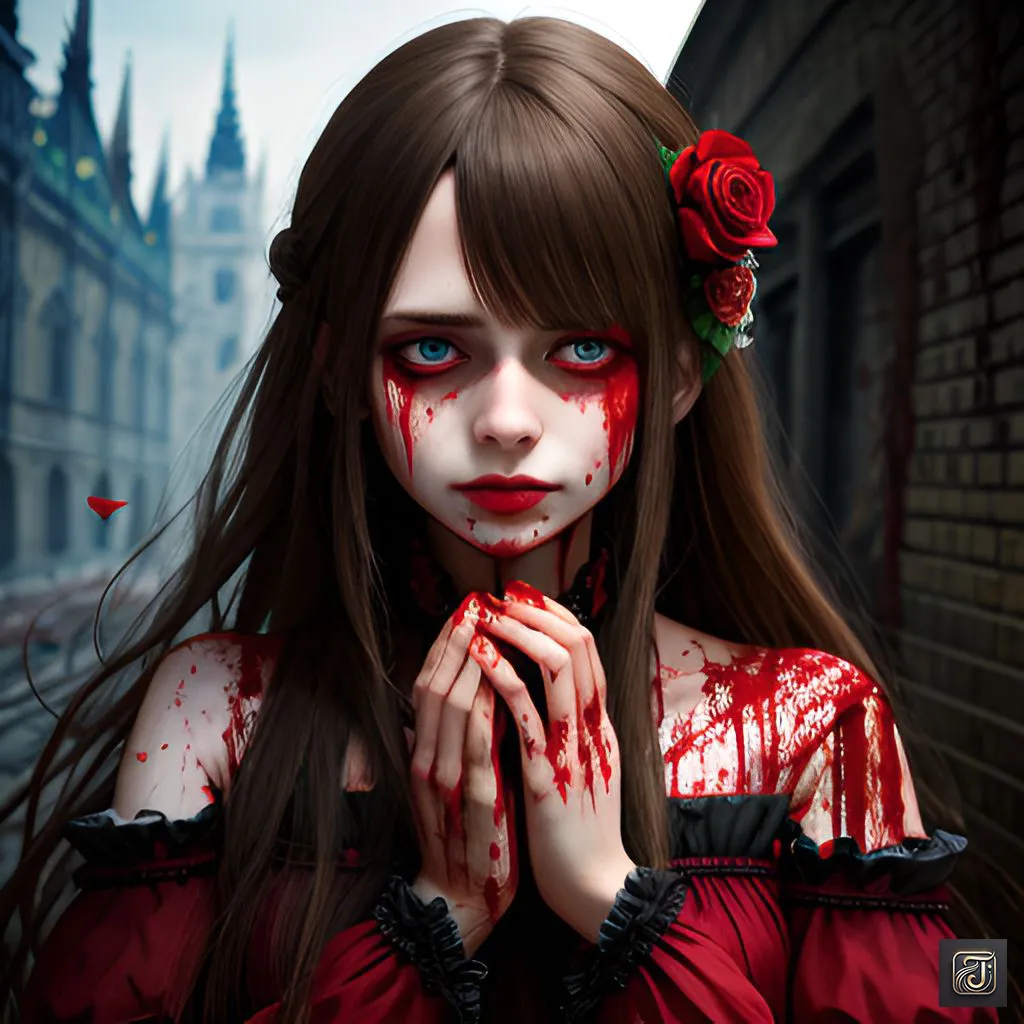
Prologue
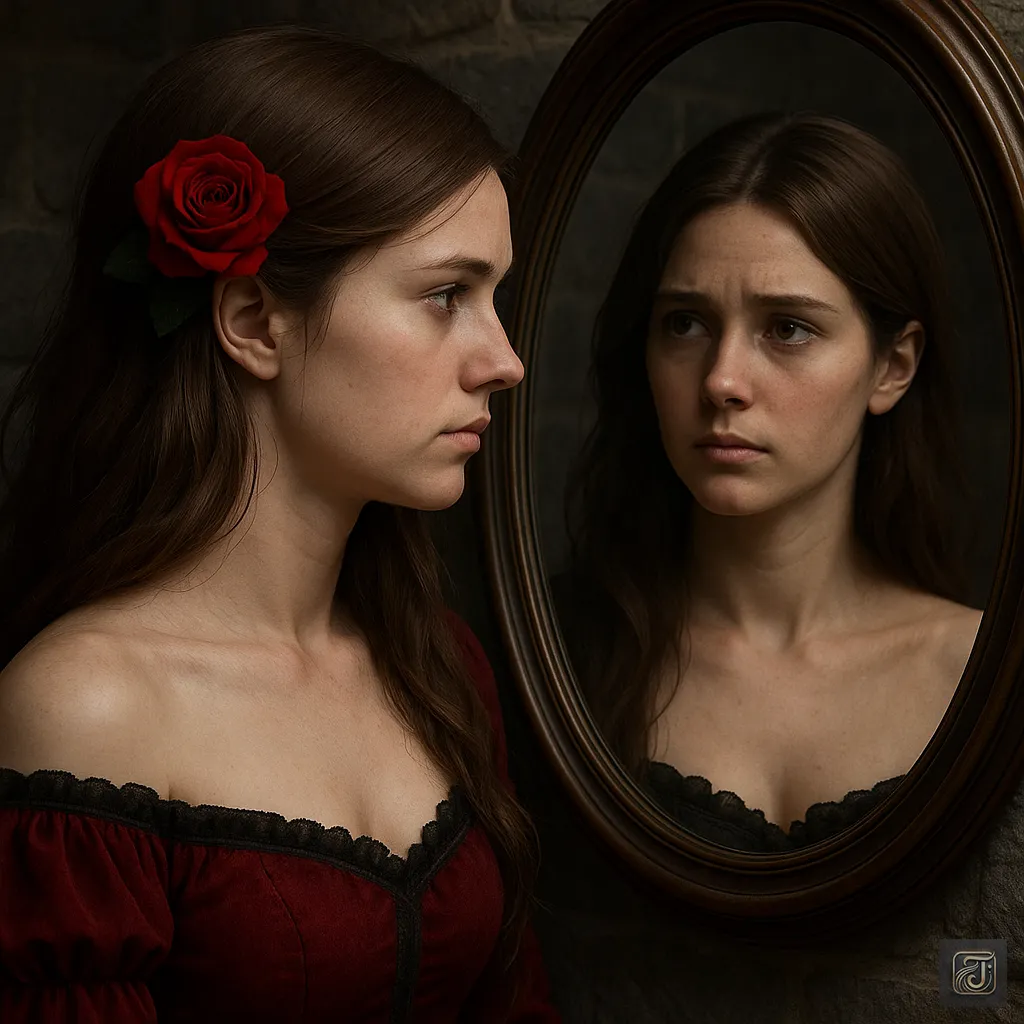
—Her radiant skin had been polished by the lives of hundreds.
“Mirror, mirror, who is the fairest of them all—?”
If there ever were a mirror that answered, “The Countess soaked in blood,”
Then perhaps… it would not be lying.

Elizabeth Báthory
A noblewoman of the Kingdom of Hungary, once renowned for her elegance and beauty.
But from a certain day onward, her name would be known by another title—

“The Blood Countess”
She bathed in the blood of virgins to preserve her youth.
In her dungeon, she tortured countless young girls, savoring their screams like fine wine.
The number reached 650—making her the most prolific female serial killer in European history.
But… was that truly the truth?

In this article, we will explore the life of Elizabeth Báthory as a human drama, told in chapters and grounded in historical testimony and context.
From noble birth and political marriage, to love and isolation, the awakening of madness, unpunished crimes, and her final days sealed behind stone walls—
Can you still call her a monster?
Chapter 1: The House of Roses and Whips
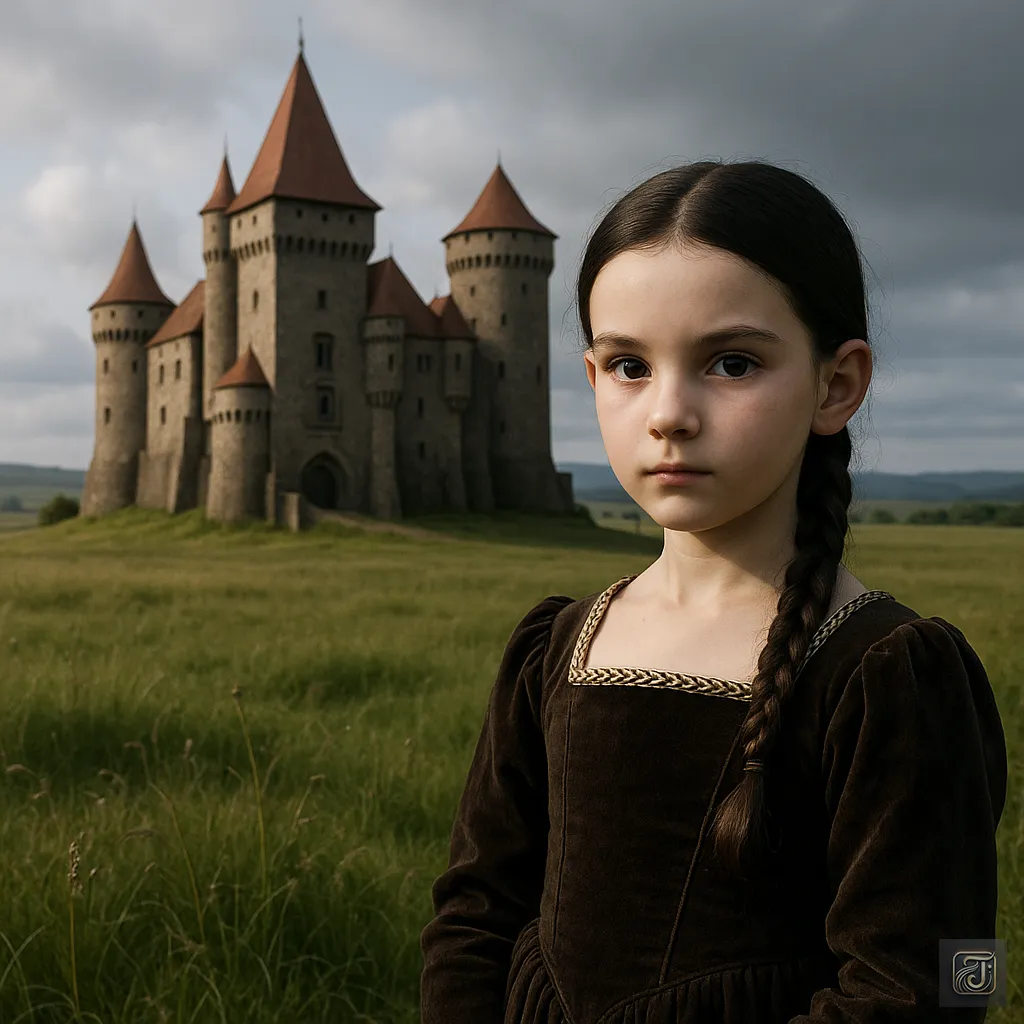
In the vast plains of Transylvania, within the Kingdom of Hungary, stood the grand estate of the Báthory family.
There, a girl was born—her features as perfectly sculpted as a statue, her eyes as dark as obsidian.
Her name was Elizabeth Báthory.
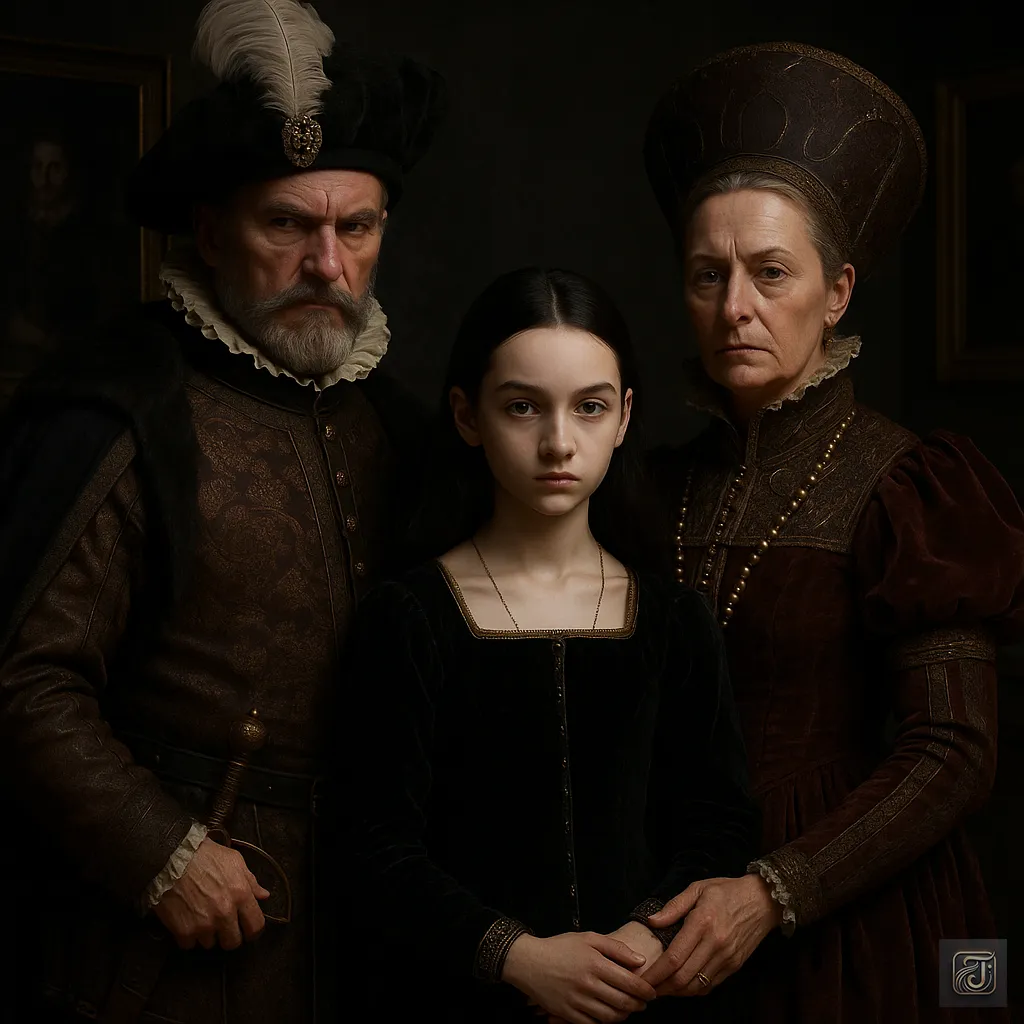
A house among houses—true nobility.
Her father, András Báthory, was a nobleman and military commander. Her mother, Anna Báthory, was a woman of considerable political influence.
But—this family bore another face as well.
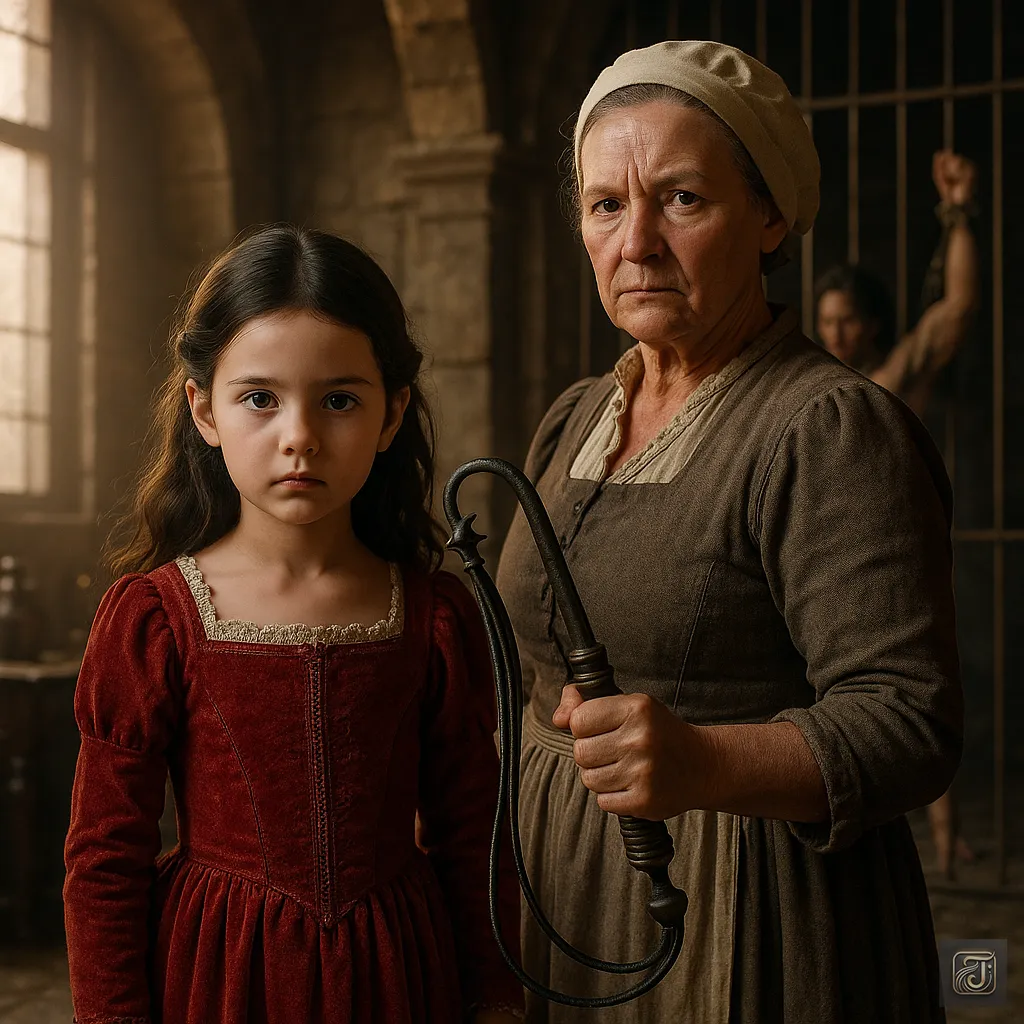
In the blood of her family ran the poison of madness and unrelenting lust for power.
From a young age, Elizabeth witnessed scenes far removed from ordinary life.
If a servant made a mistake, the whip was mercilessly brought down.
When criminals were caught, they became spectacles of public torture.
“This is how the world works, my lady,” her nursemaid would say with a smile—
As she held a whip laced with iron claws.
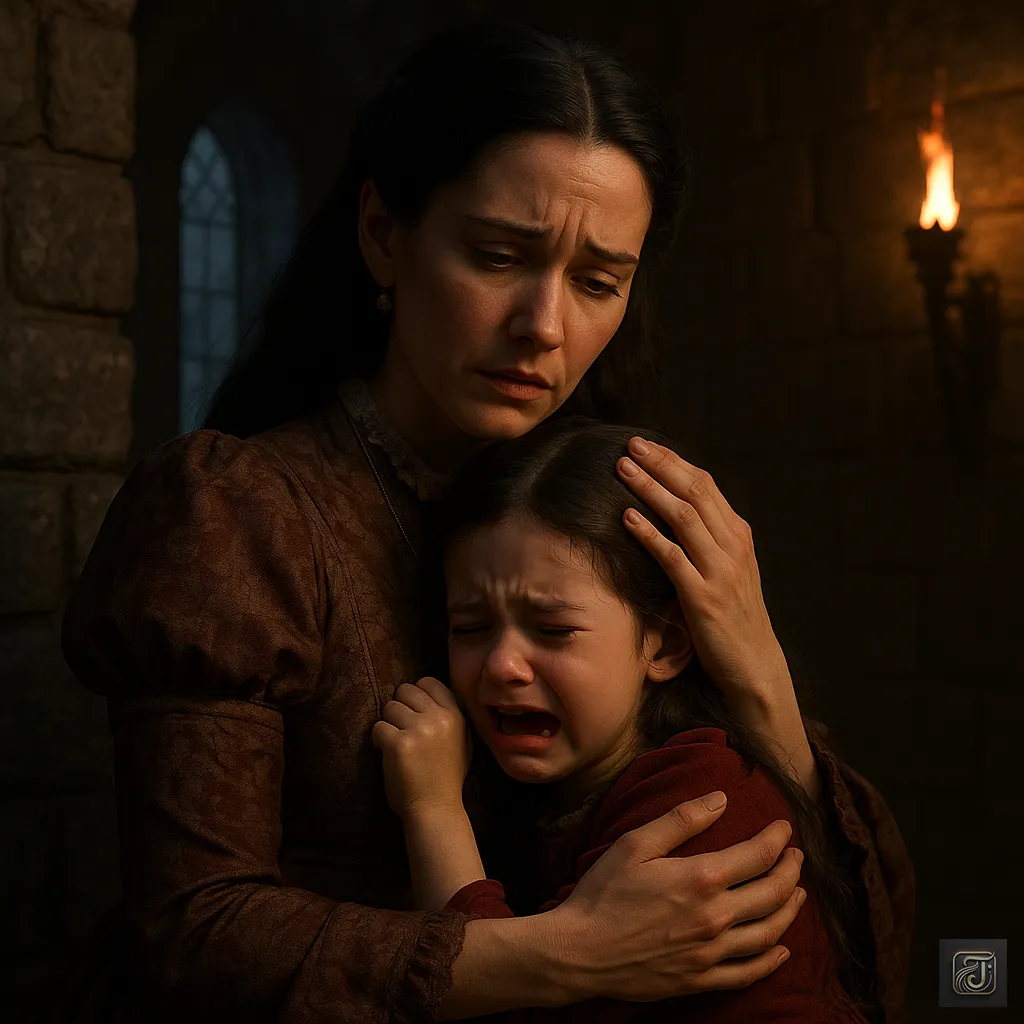
At first, Elizabeth was afraid.
She cried.
She ran into her mother’s arms, seeking comfort.

But one day, when a maid was slapped across the face right before her eyes,
Elizabeth… smiled—ever so faintly.

Her education was thorough—relentless.
Academics, languages, etiquette, astrology… even the basics of human dissection and dark magic.
“All of this is to grant you the wisdom befitting your noble blood,”
Her tutor said, placing a dissection knife in her hand.
That night, Elizabeth had a dream.

Crimson roses, dripping with blood, bloomed wildly in her palm—
When Elizabeth was ten, a peasant boy was brought to the castle.
Caught for theft, he was hung in the dungeon’s torture chamber.
Elizabeth was ordered to witness it.
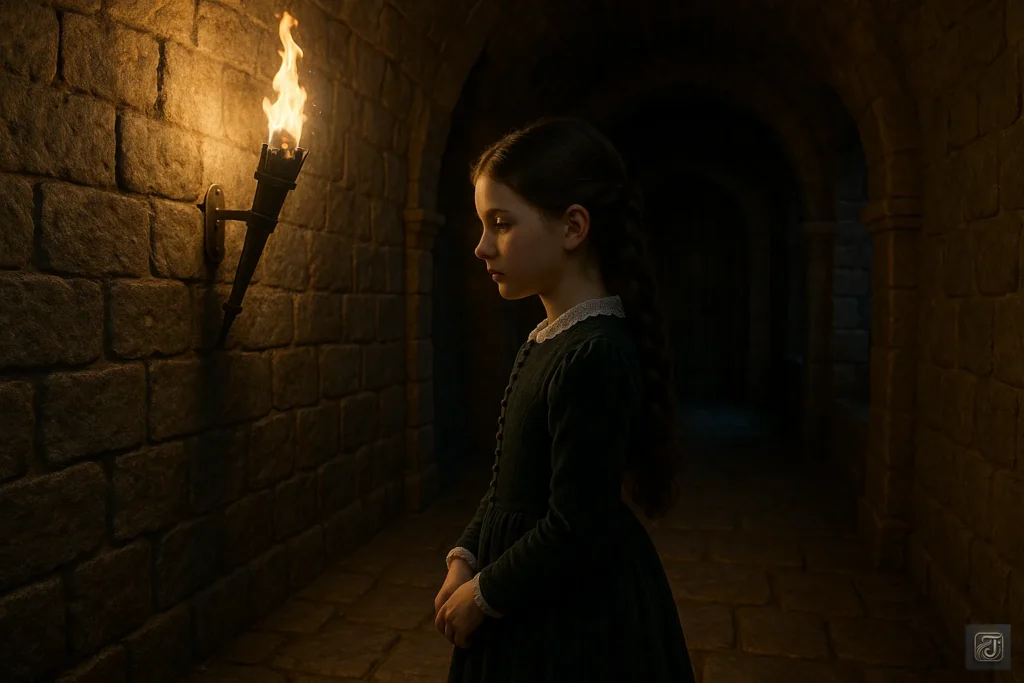
Mother:
“You must learn fear.”
“And you must understand the power to rule through it.”
Each time the boy screamed, a strange sensation stirred within her heart.
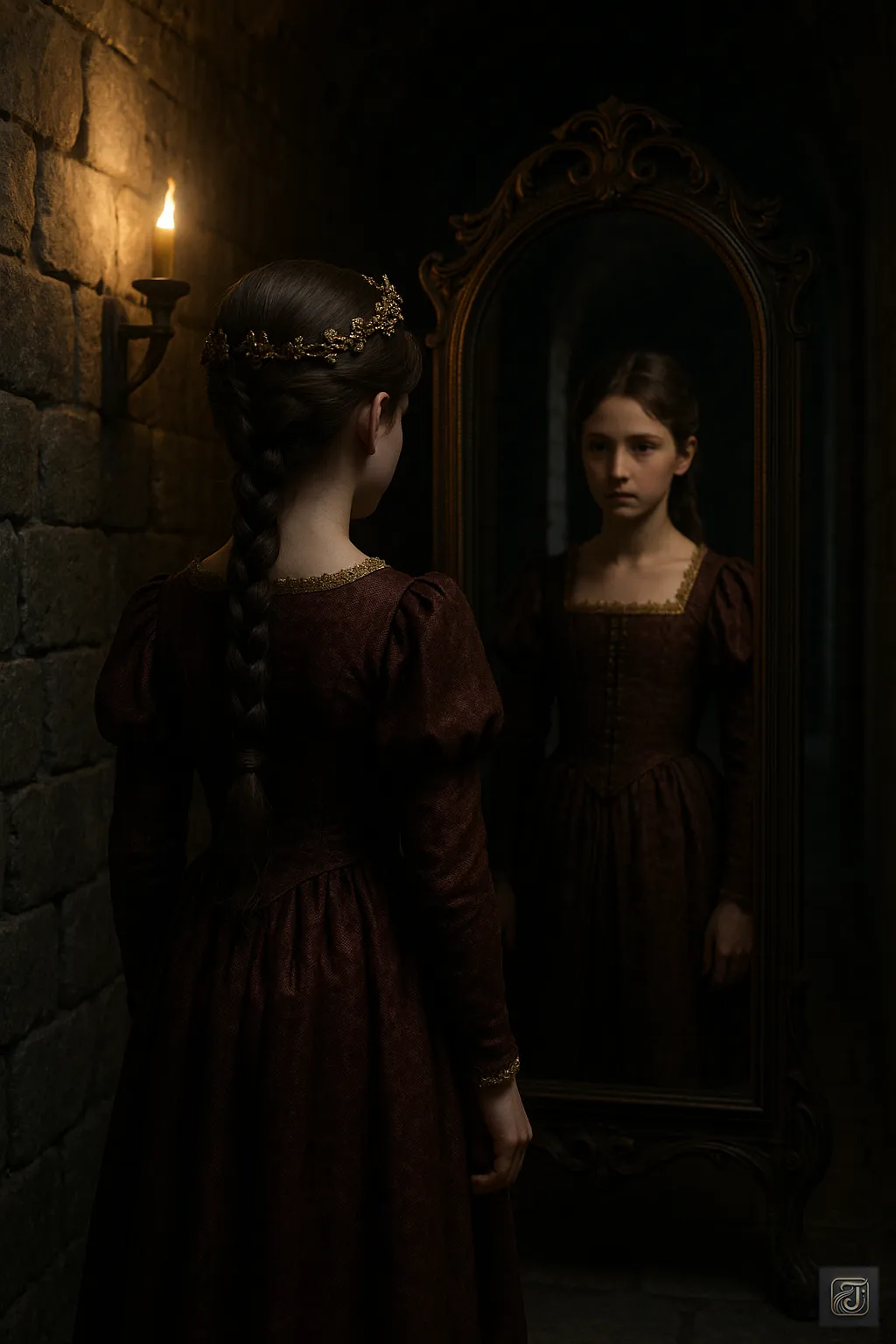
A trembling thrill—followed by a sweet, intoxicating rush.
It was in that moment… that something inside her awoke.
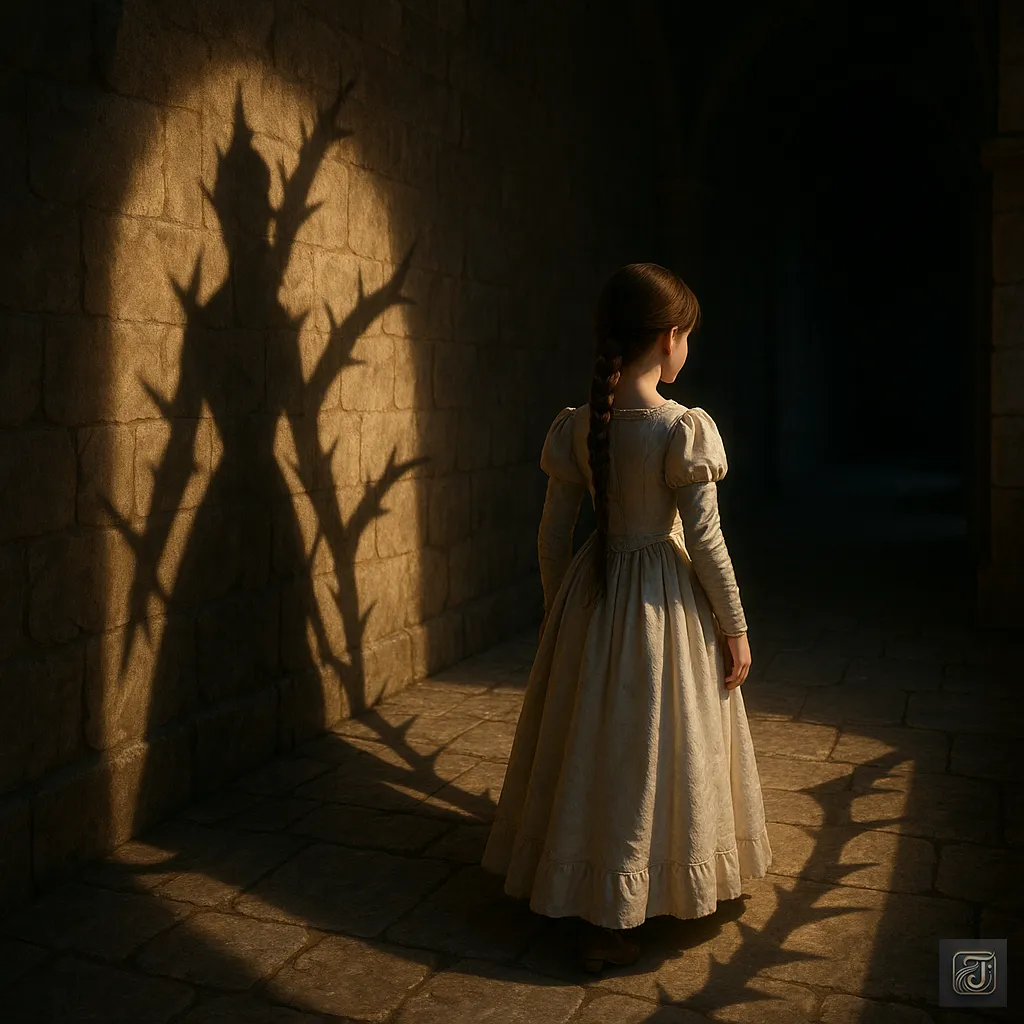
She may still have been pure then.
But deep within her heart, the darkness had already begun to take root.
The rose was blooming—but its stem bore sharp, merciless thorns.
And those thorns… would one day drink the blood of many.
Chapter 2: The Iron Husband, Shadow of the Battlefield
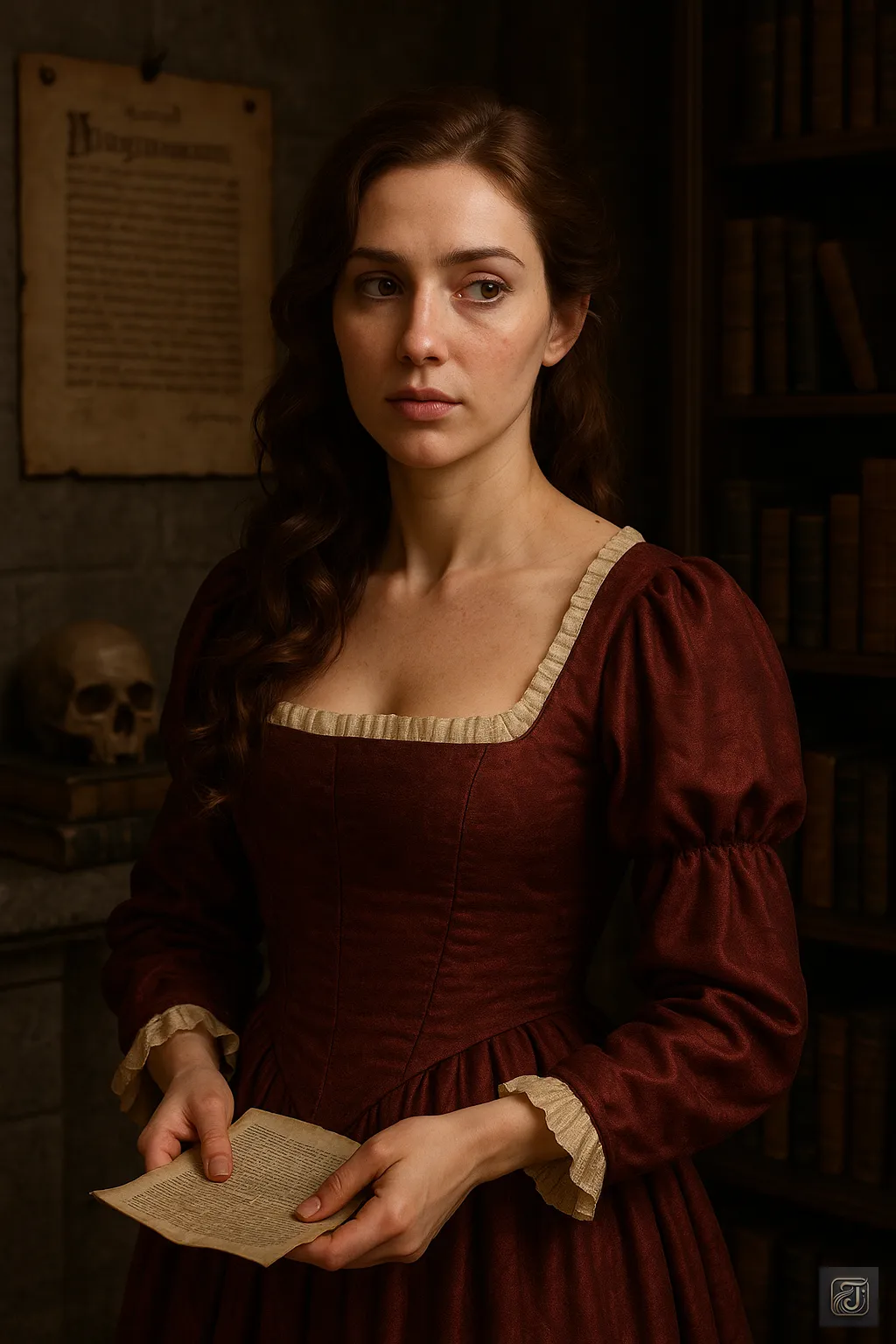
Elizabeth Báthory, fifteen years old.
Still a girl in age.
And yet, in her eyes already gleamed the light of a ruler—and the shadow of a destroyer.
Then, without warning, came a contract cloaked in noble tradition—
a political marriage.

Her betrothed: Ferenc Nádasdy.
Though of lower birth than the Báthorys, he had earned fame through sheer martial prowess—
a warrior feared and revered as “the Black Hero.”
It is said he claimed countless heads in battle against the Ottoman Empire,
and mastered the grim art of execution.
On the day of their union, Elizabeth stood in a chapel,
draped in a gown adorned with silver embroidery,
and made her vow.
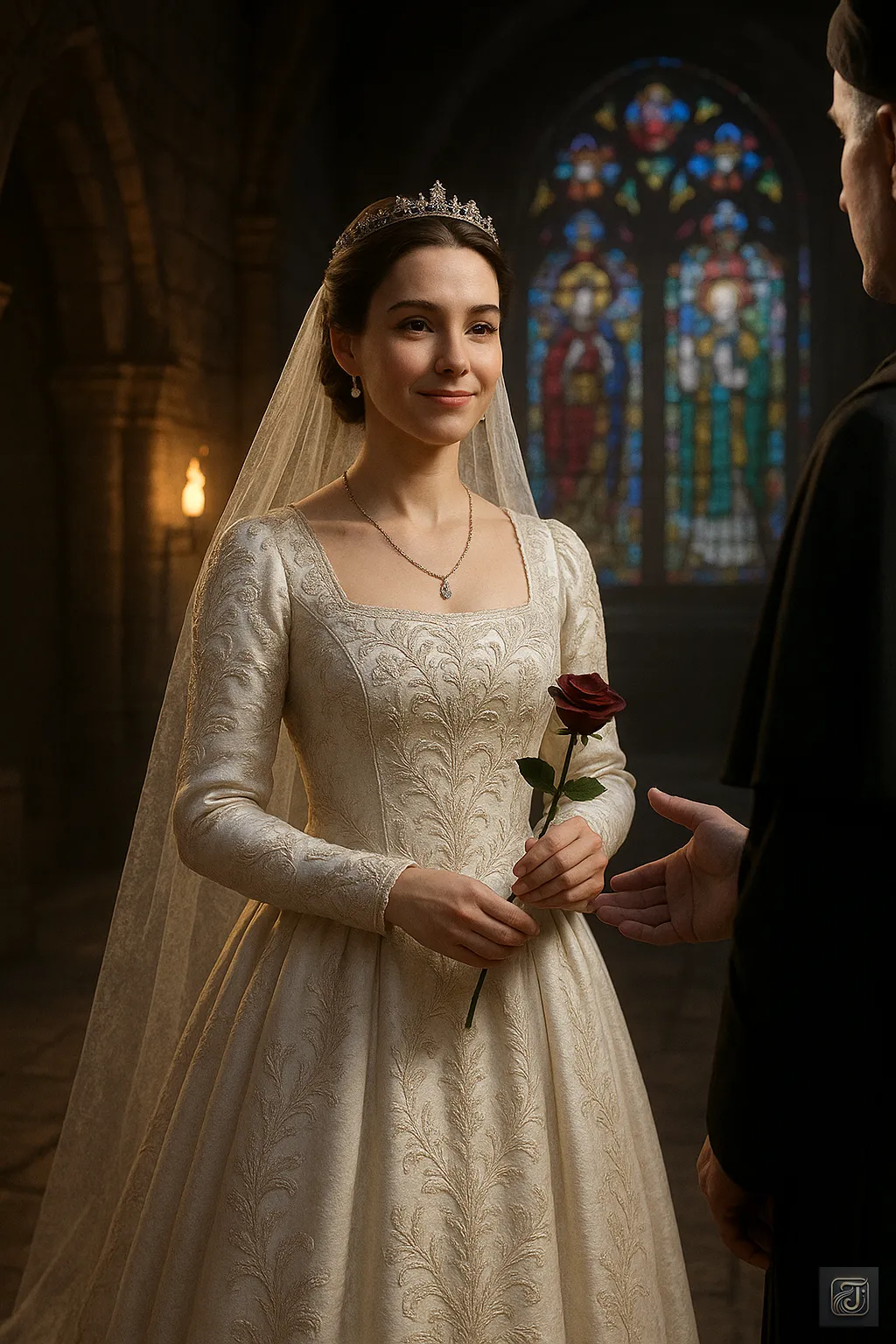
Priest:
“Do you swear to be faithful to this man, in sickness and in health?”
asked the priest.
Elizabeth said nothing. She only smiled—
And that was her first lie.
Ferenc was a man who showed no emotion.
Calm, disciplined, a merciless butcher on the battlefield.
And yet, toward Elizabeth, he revealed a strange kind of tenderness.
One night, he took her hand and whispered:
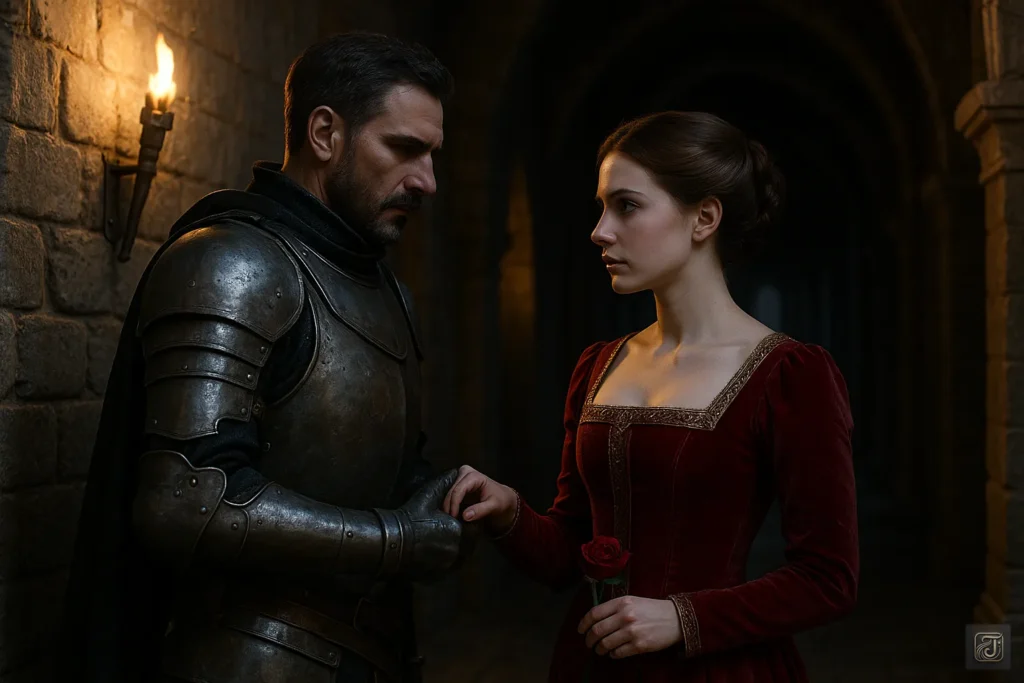
Ferenc Nádasdy:
“You possess… both beauty and madness.
But without the art of restraint, that gift becomes a curse.”
His words stirred something within Elizabeth.
This man—he saw the swirling desires buried deep inside her.
And that was terrifying.
And yet… it thrilled her.
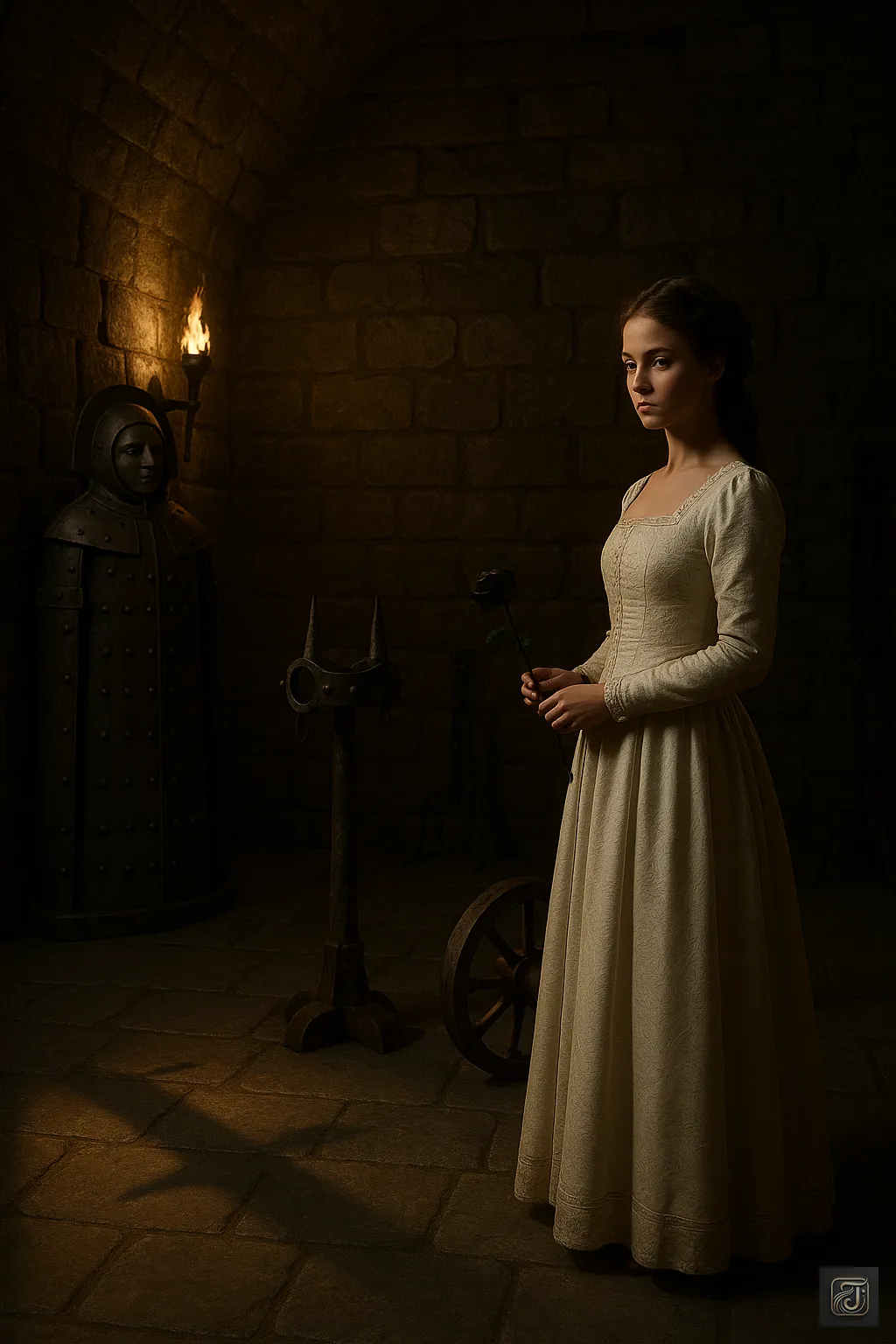
Ferenc returned to the battlefield.
He seldom came back to the castle.
What he left behind were trophies of war—
and instruments of torment.
An iron maiden. Spiked restraints.
A flaying wheel.
Along with them, he wrote:
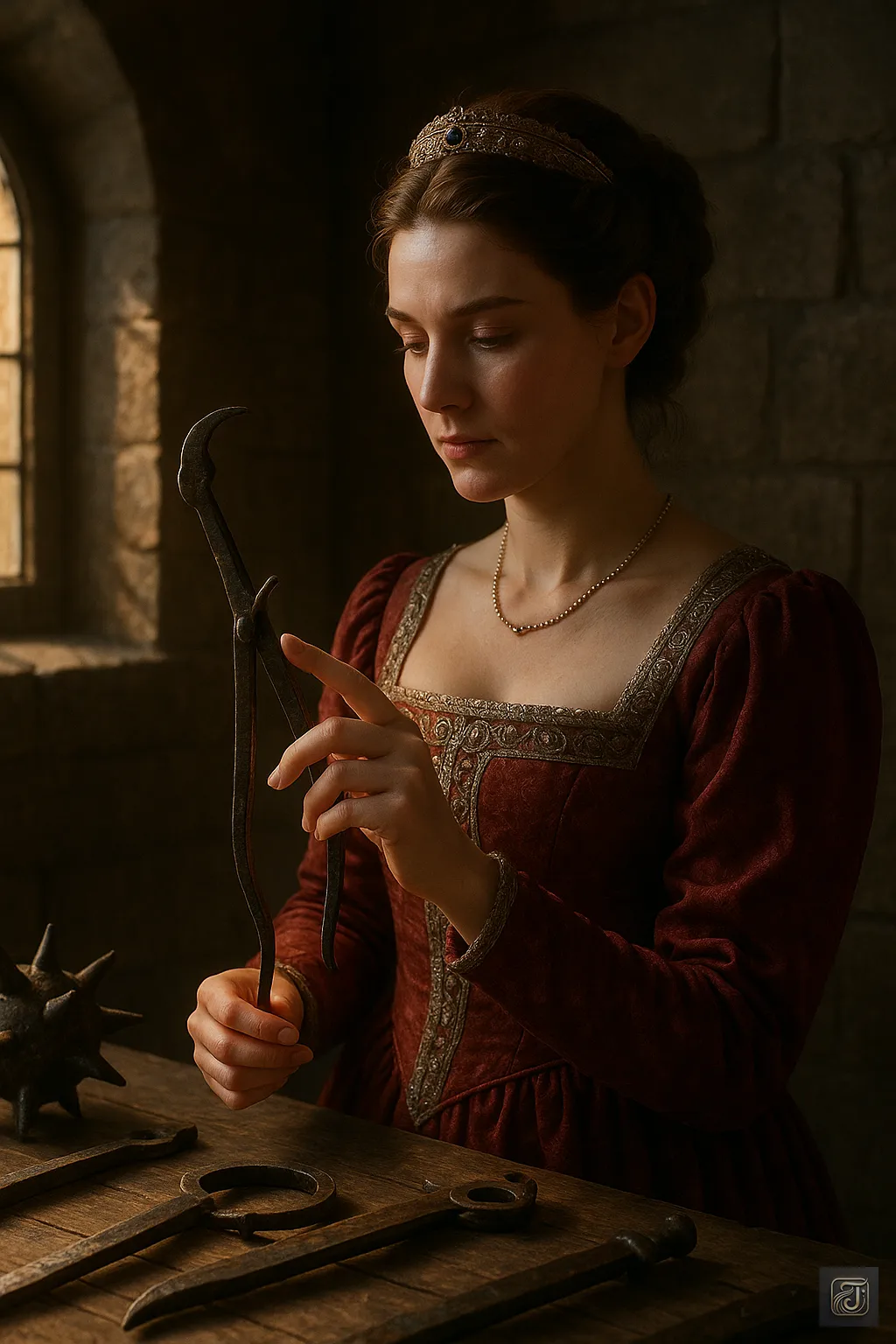
Ferenc Nádasdy:
“Use these to punish your servants.”
“To coddle them is to raise your own enemies.”
Elizabeth carefully polished each one,
her fingers tracing their cruel edges—
smiling all the while.
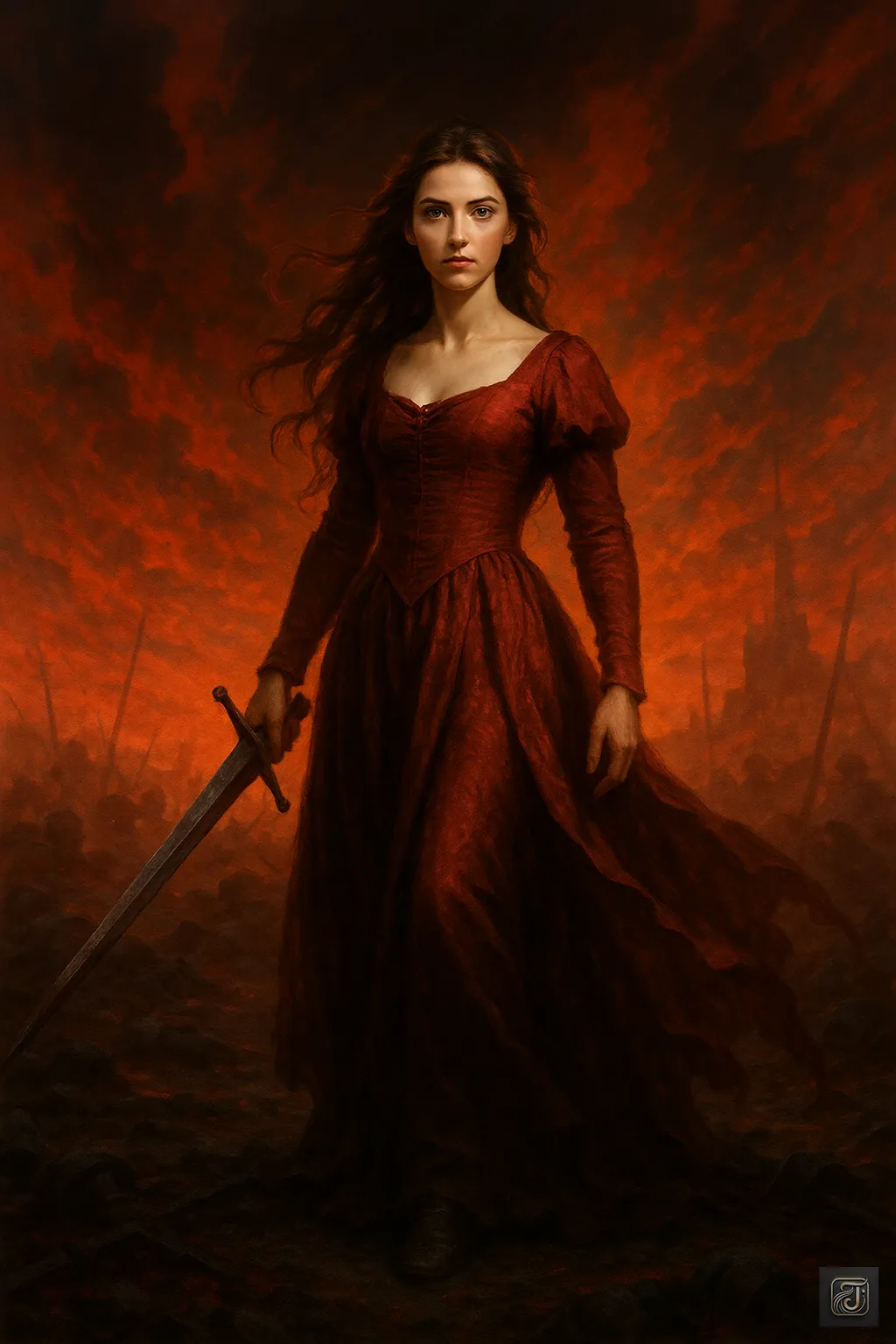
On nights without her husband, Elizabeth dreamed.
She stood atop a mountain of corpses,
her gown soaked in blood,
Swinging a sword with wild abandon
across a battlefield drenched in death.
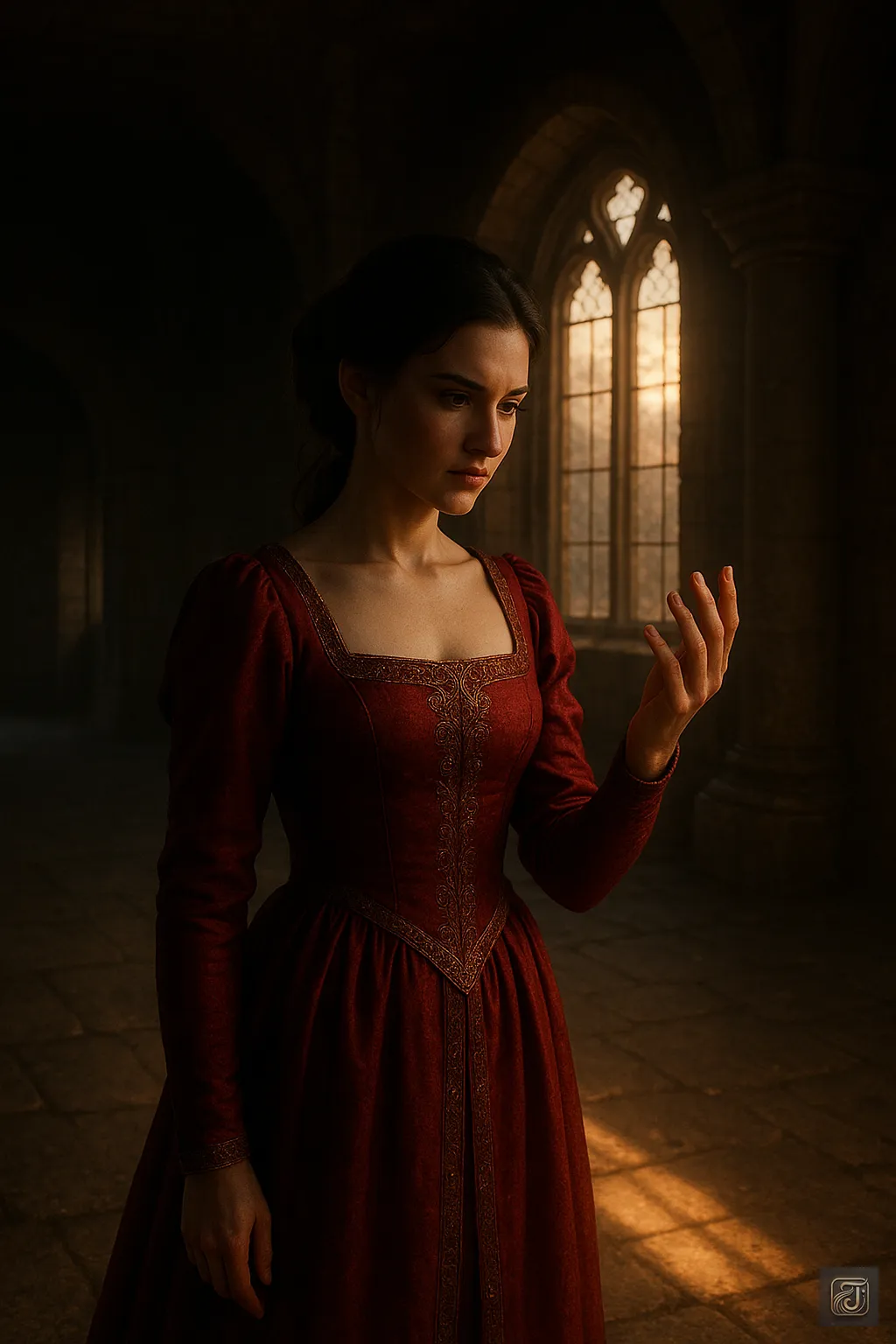
And when she awoke, a faint trace of crimson stained her hand.
Whether it was dream or reality—she could no longer tell.
By the end of this chapter, a single truth had crystallized within Elizabeth:
“Pain and beauty walk hand in hand.”
In that belief, she drew from her husband’s battlefield…
and resolved to build one of her own.
It’s stage: her stronghold—Čachtice Castle.
Chapter 3: The Curse of Youth
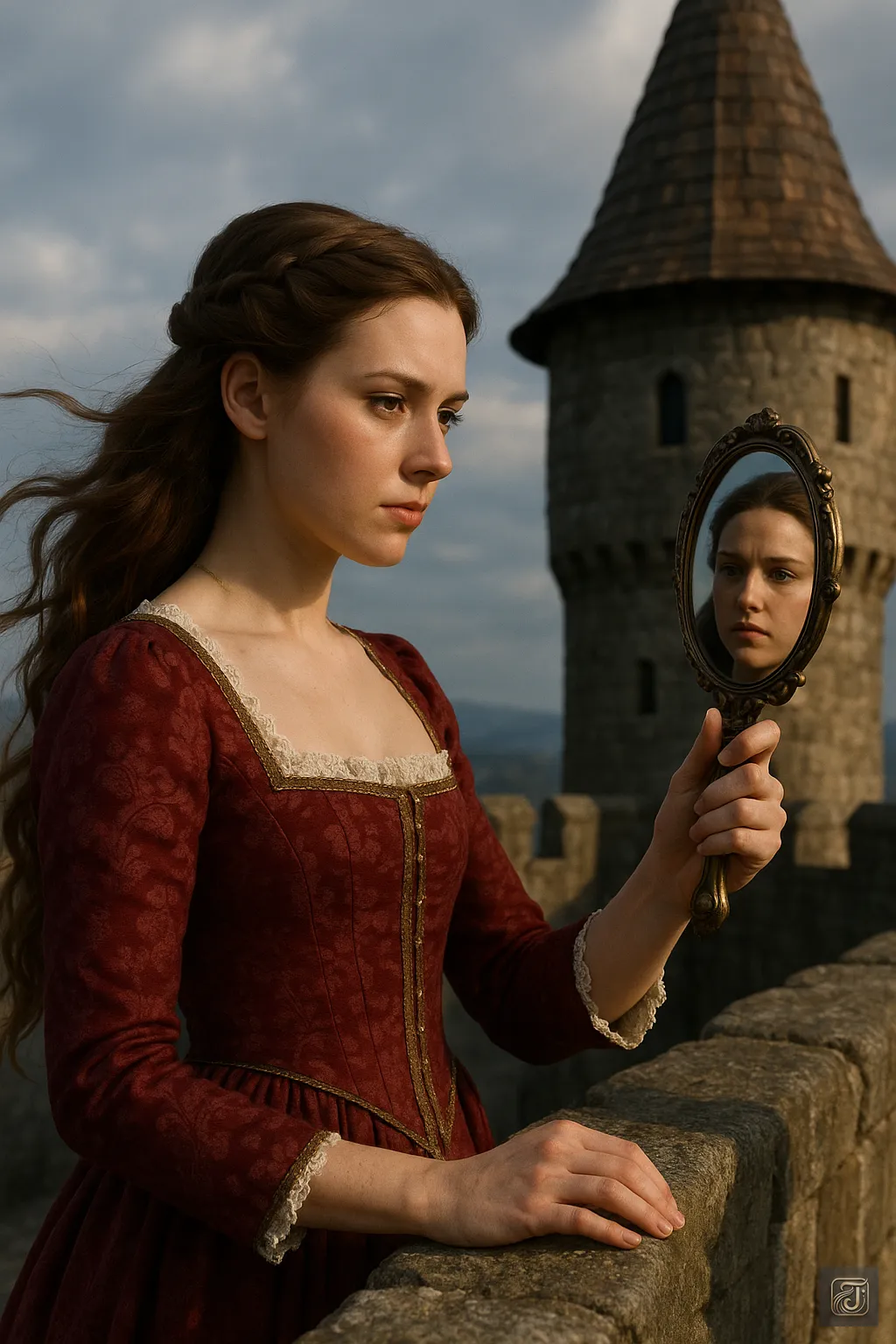
On a blustery spring day, atop the tower of Čachtice Castle, Elizabeth gazed into a mirror.
She was still in her mid-twenties—her skin smooth, her eyes sharp and clear.
And yet, she felt a faint twinge of fear.
—A shadow beneath her eye.
—The contour of her cheek, ever so slightly softer than yesterday.
They were changes no one else would notice.
But she did.
And from that moment on, Elizabeth Báthory’s war against aging had begun.

No matter how beautiful a woman may be,
She will one day grow old.
It is inevitable.
That day always comes.
And Elizabeth was no exception.
But to her, that truth was nothing short of despair.
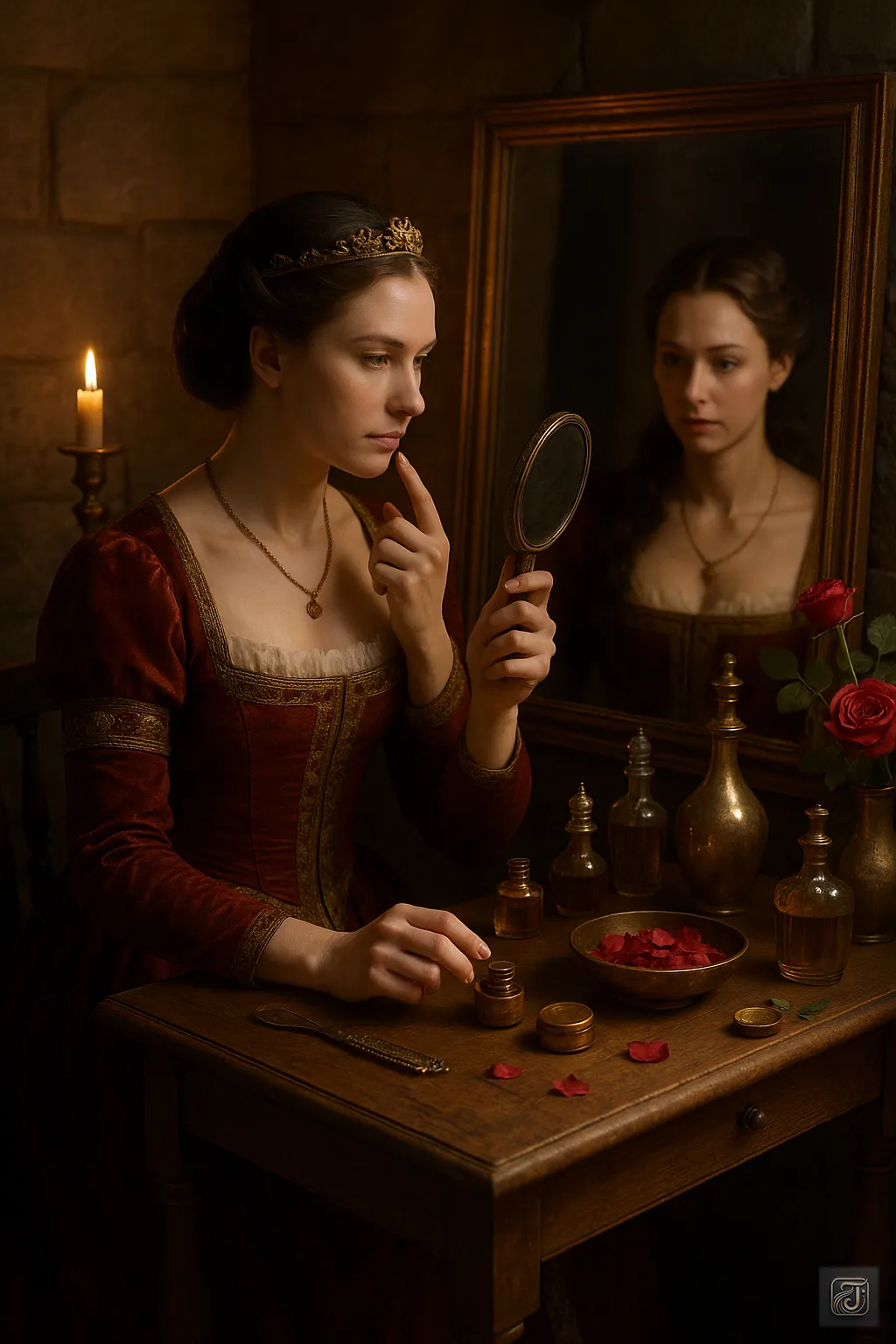
Elizabeth poured all her time and wealth into beauty.
She tried every luxurious treatment, every cutting-edge remedy of the age.
But no matter how she resisted, aging would not stop.
It was as if all her efforts were mocked—
crushed beneath the weight of inevitability.
Each time she looked into the mirror,
she was forced to confront that cruel, unrelenting truth.
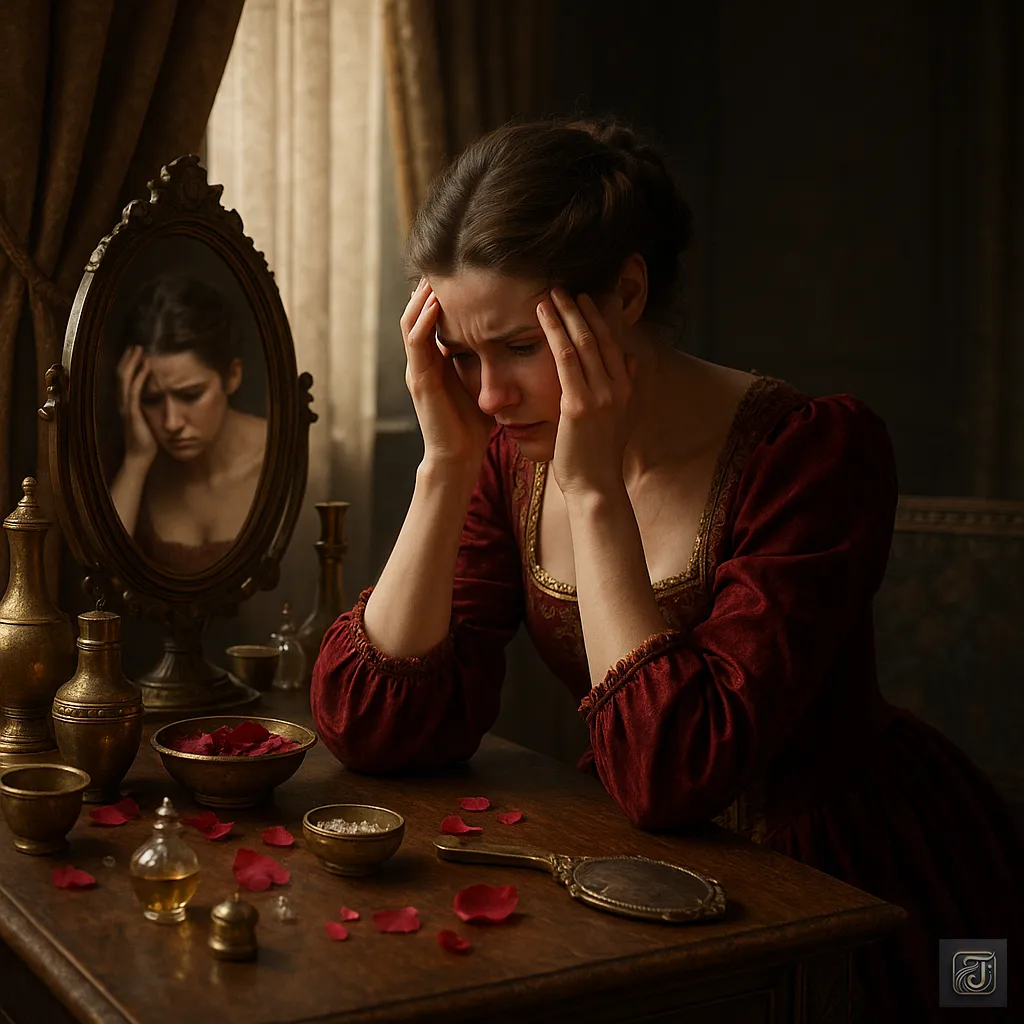
Erzsébet Báthory:
“What am I supposed to do…?”
“What am I still lacking…?”
Her acts of torture grew ever more brutal.
As if, by destroying the beauty of others,
She could somehow hide the aging creeping into her own.
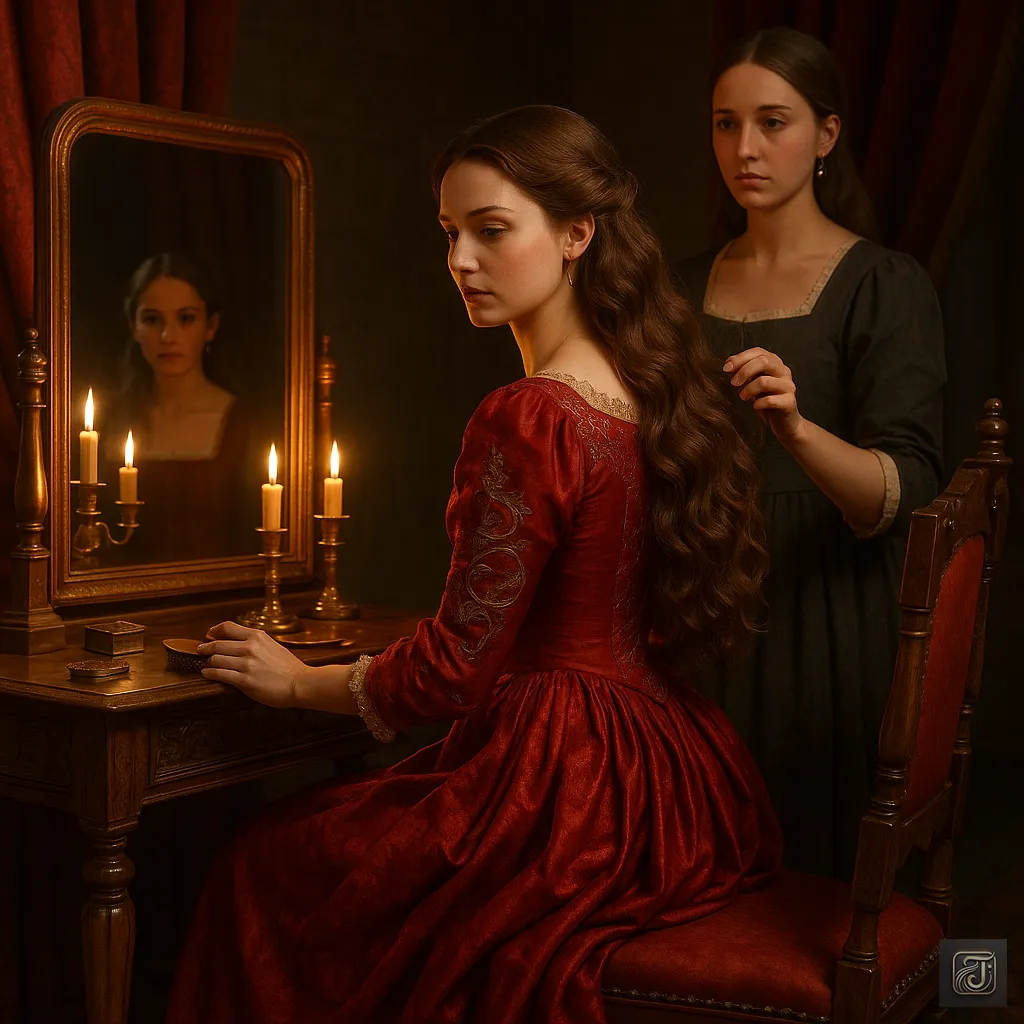
One day, as a young maid was combing her hair,
The comb snagged and tugged sharply at Elizabeth’s scalp.
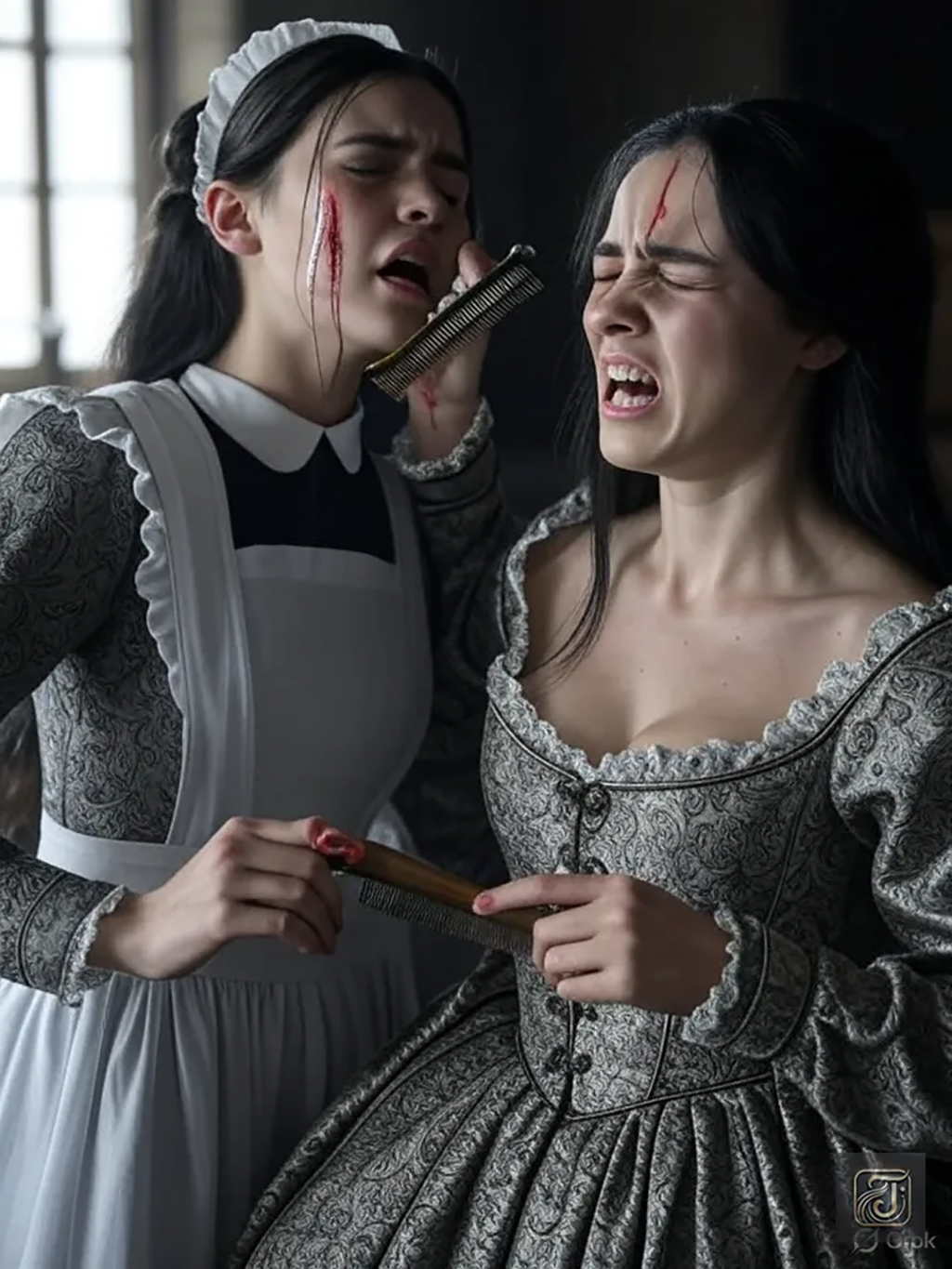
Startled by the pain, Elizabeth spun around—
her sharp nails slashing across the maid’s cheek.
Blood splattered, landing on the back of her hand.
And then—
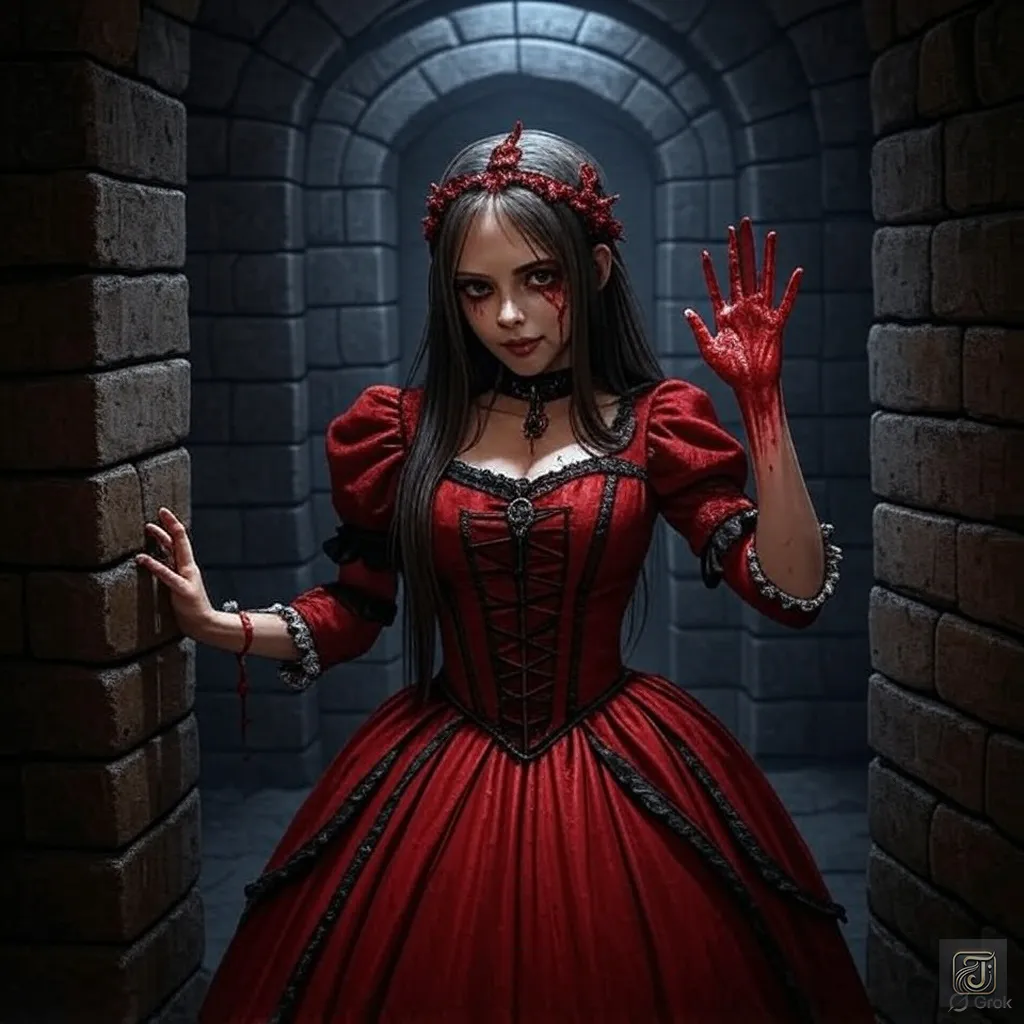
The patch of skin where the blood had touched—
It seemed whiter, smoother… more radiant than before.
Erzsébet Báthory:
“…It can’t be,”
Elizabeth whispered, staring into the mirror
As she slowly wiped the blood away.
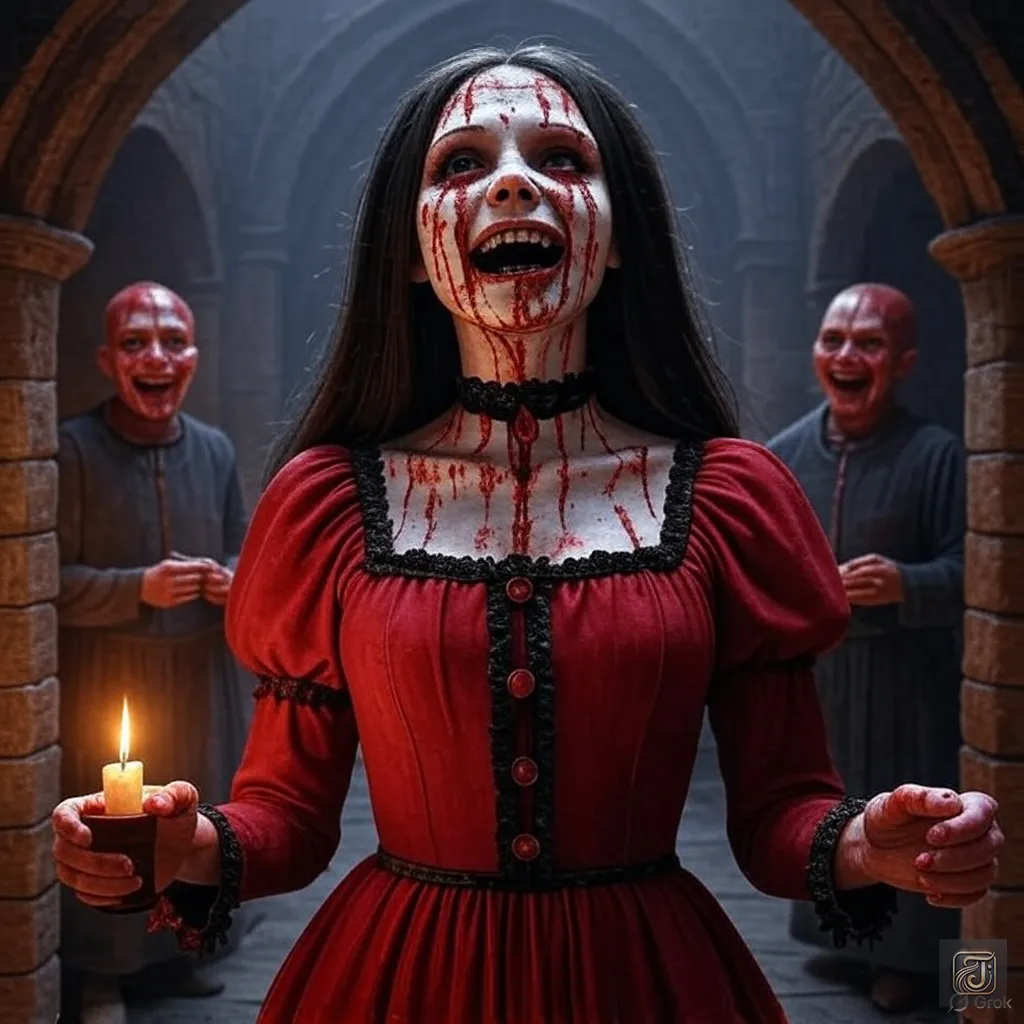
Erzsébet Báthory:
“Yes… blood! It was the blood of young women I needed!”
The very next day, the maid was gone.
Whether it was coincidence, delusion, or fate—no one can say.
But Elizabeth… had become certain.
“Youth can be sustained by stealing the lives of others.”
From then on, she summoned young and beautiful girls to her service—
only for them to vanish, one after another.
At first, the disappearances were few.
Quietly written off as “runaways.”
And Elizabeth smiled, satisfied.

Erzsébet Báthory:
“I feel as if I’ve returned to the girl I was at eighteen.”
But beneath that smile, a storm of deep, bottomless anxiety was always swirling.

Was the reflection in the mirror truly growing younger—
Or had her eyes gone mad?
Each time her bloodstained hands touched her skin,
The hollow void deep within her heart
seemed to widen just a little more.
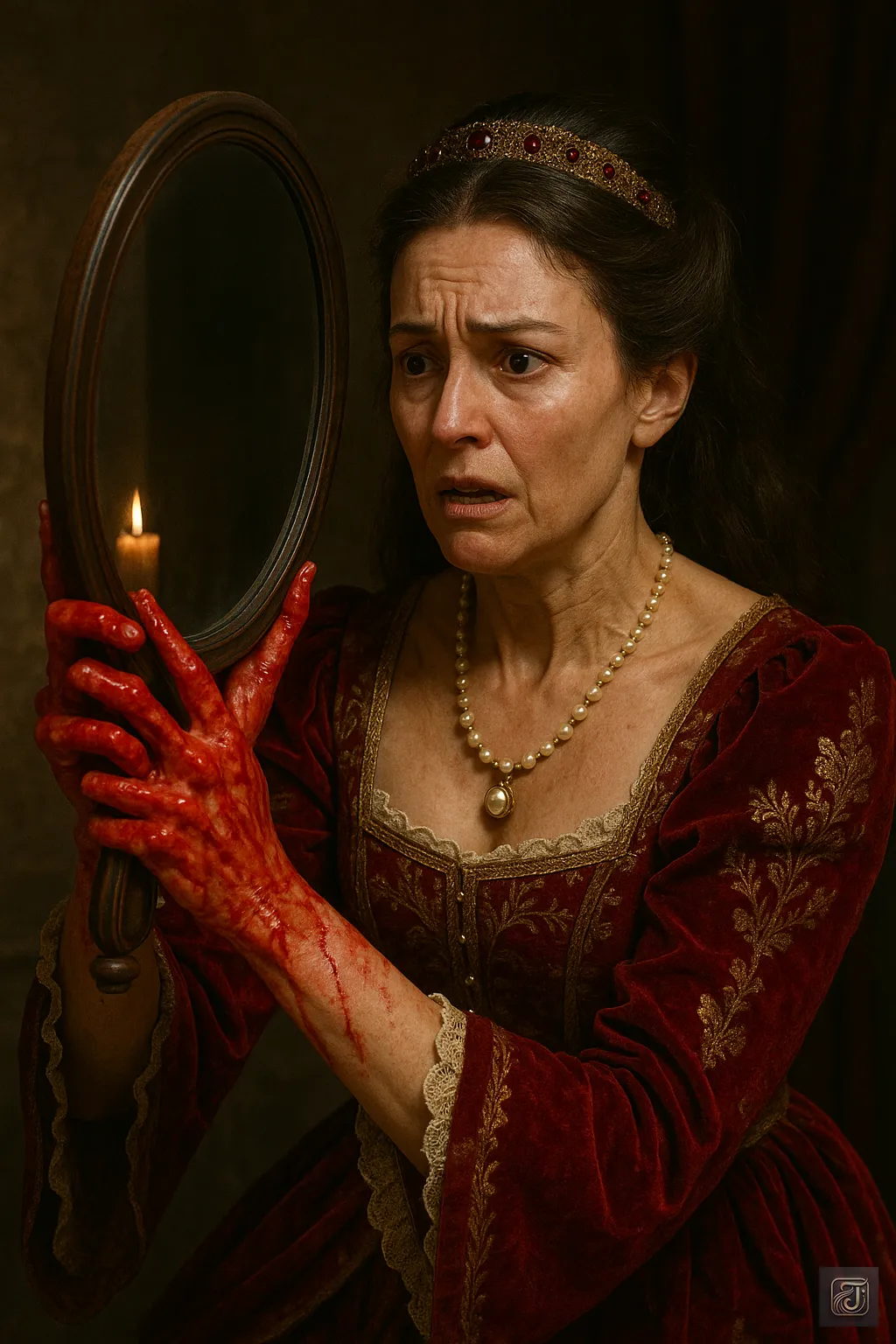
The curse of youth was never truly the fear of aging—
But the fear that once she aged,
She would no longer be loved.
It was hunger—for love, for validation.
And that hunger soon twisted beyond the excuse of beauty,
becoming a ritual.
Ritual soaked in blood.
The scent of iron lingered constantly beneath Čachtice Castle.
And from this time forward, people began to call her by a new name—
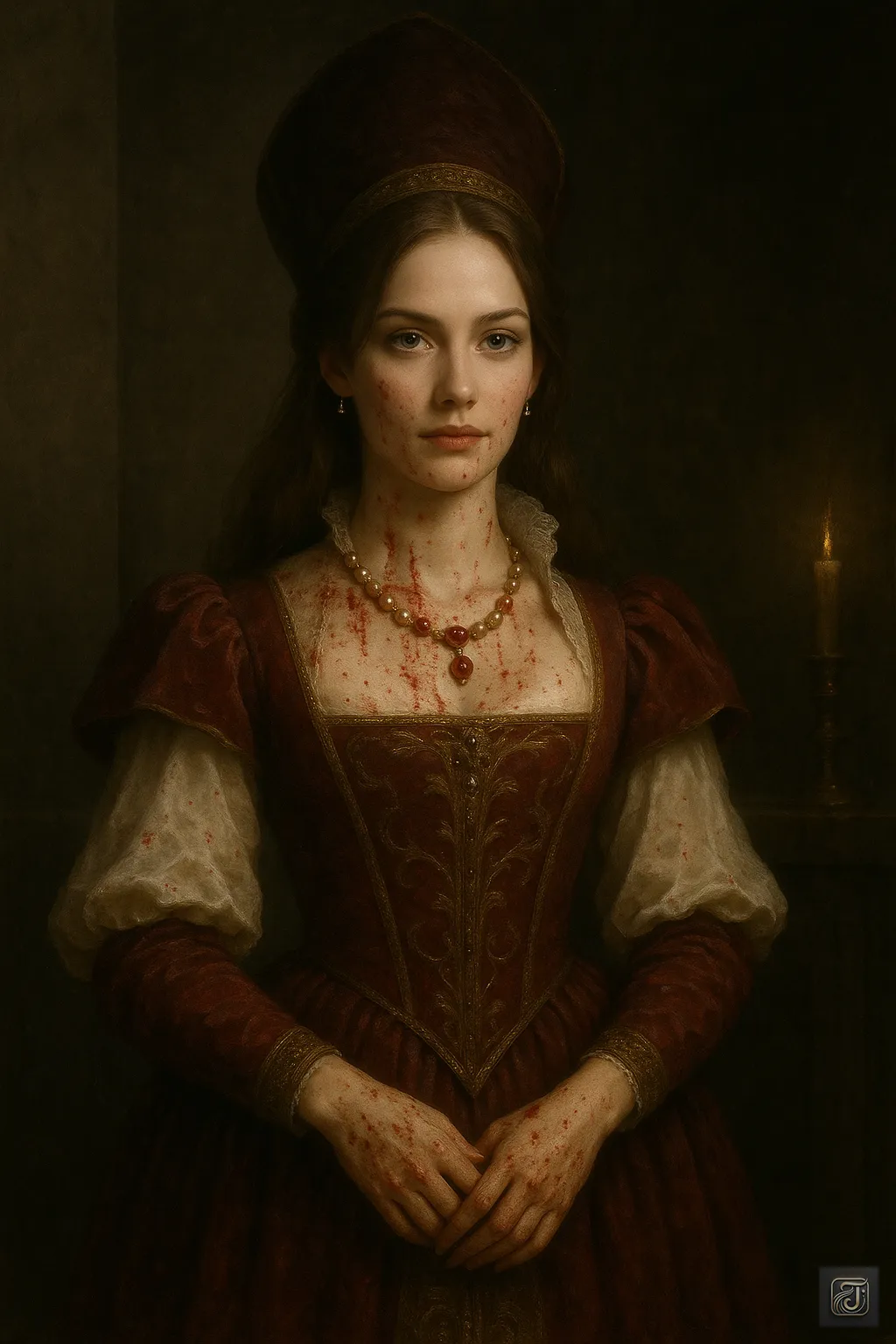
“The Blood Countess.”
Chapter 4: The Birth of the Demoness
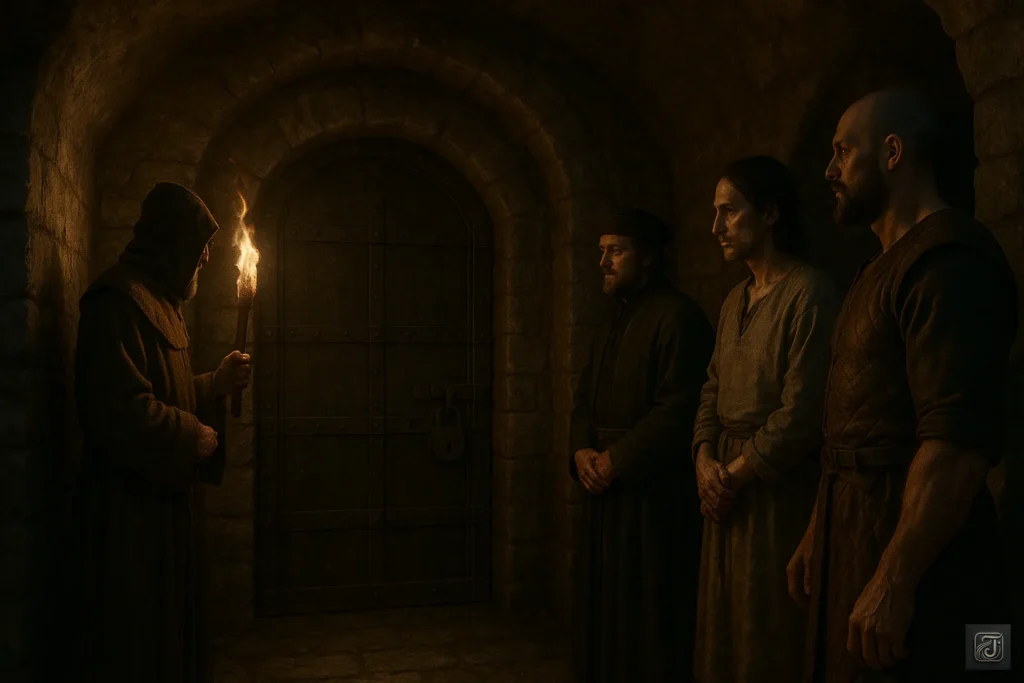
Beneath Čachtice Castle, there was a room whose door was never to be opened.
A stone cell untouched by light, reeking of iron and blood, where even the air seemed to rot.
Only a select few were ever permitted to enter.
And those few were the ones who aided Elizabeth—
The ones who upheld her rituals.
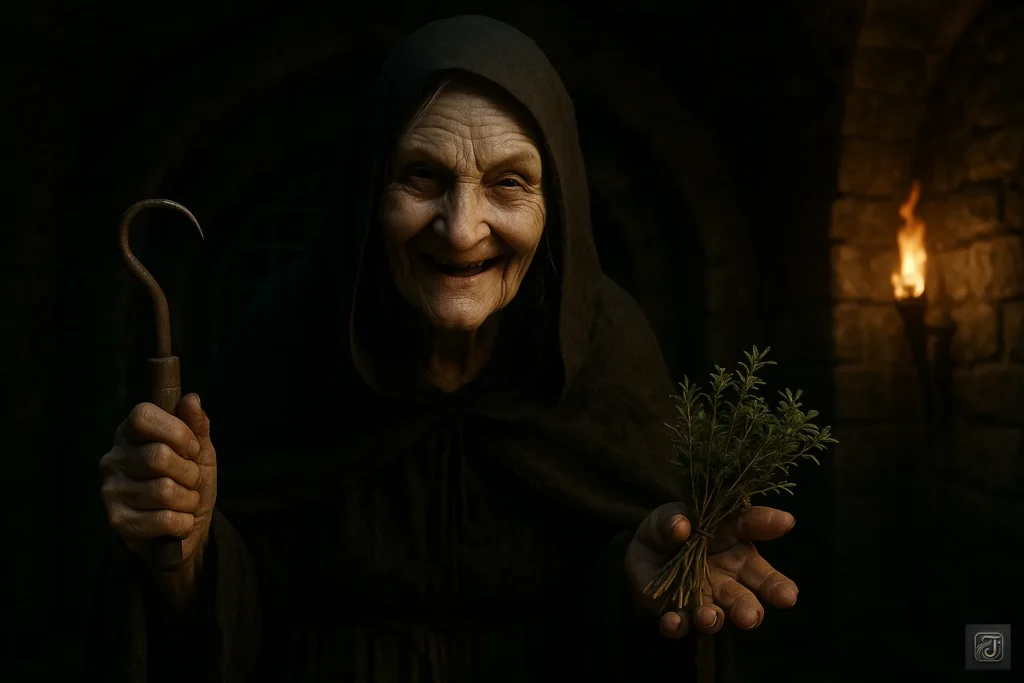
The first to appear was an old woman named Ildikó.
Once accused of witchcraft but spared the flames,
she had since become Elizabeth’s “dark advisor.”
Ildikó:
“Virgin’s blood must be used before it cools, my lady.
The fresher it is, the stronger the effect.
Body fluids too… oh yes, mmhmm…”
She chuckled, pulling from her robes a bundle of herbs—
and a clawed hook made for tearing nails.
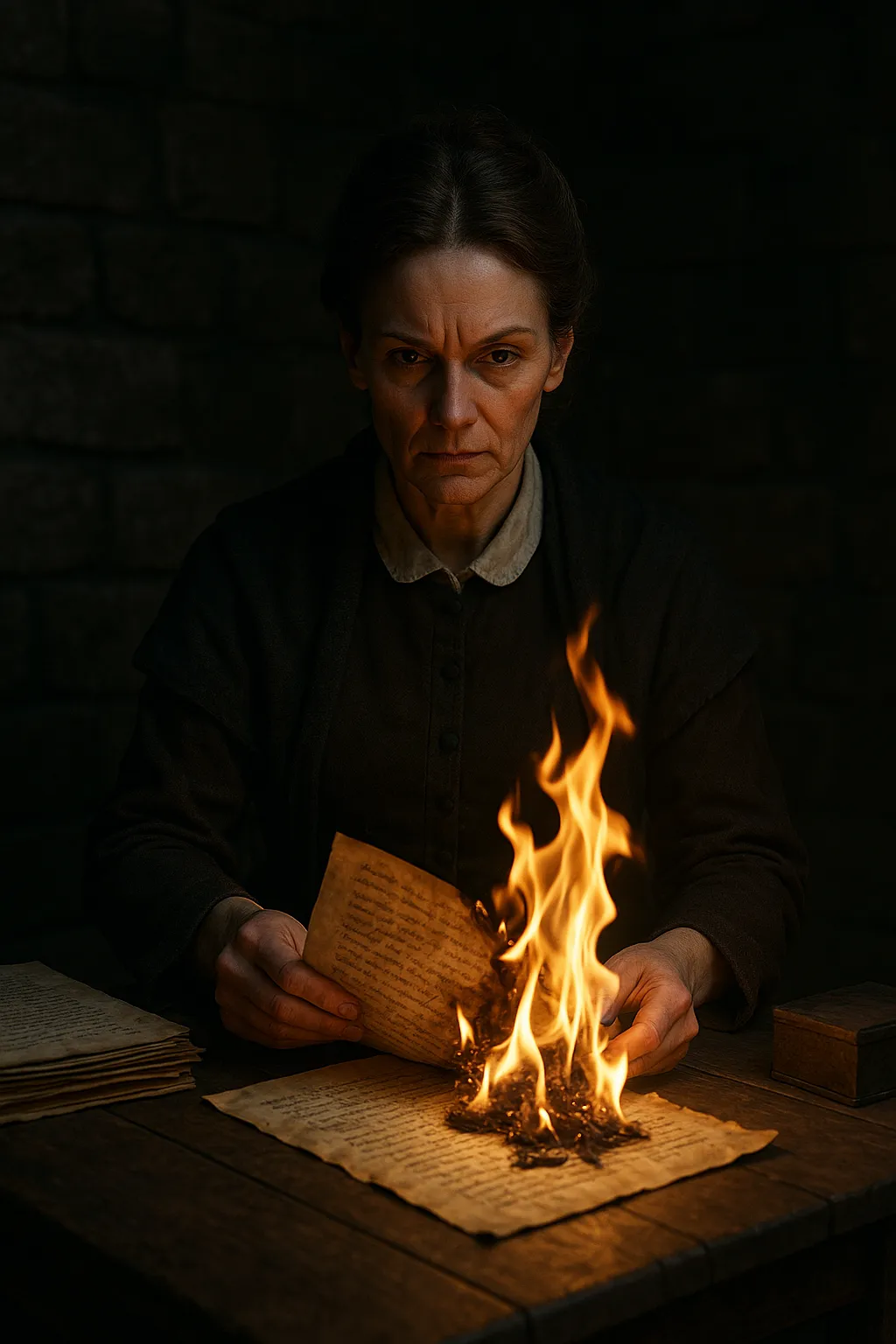
Next came Dorota.
Officially the head steward of the castle—graceful, composed.
But in truth, she was the cold-blooded handler behind the scenes:
procuring girls, erasing evidence.
Dorota:
“If we bring them in under the guise of ‘employment,’ no one will question it.
And if they vanish—well, the war will take the blame.”
With those words, she burned their records,
erasing the girls not only from the castle…
But from history itself.
Torture and murder became ritual.
A pattern was born.
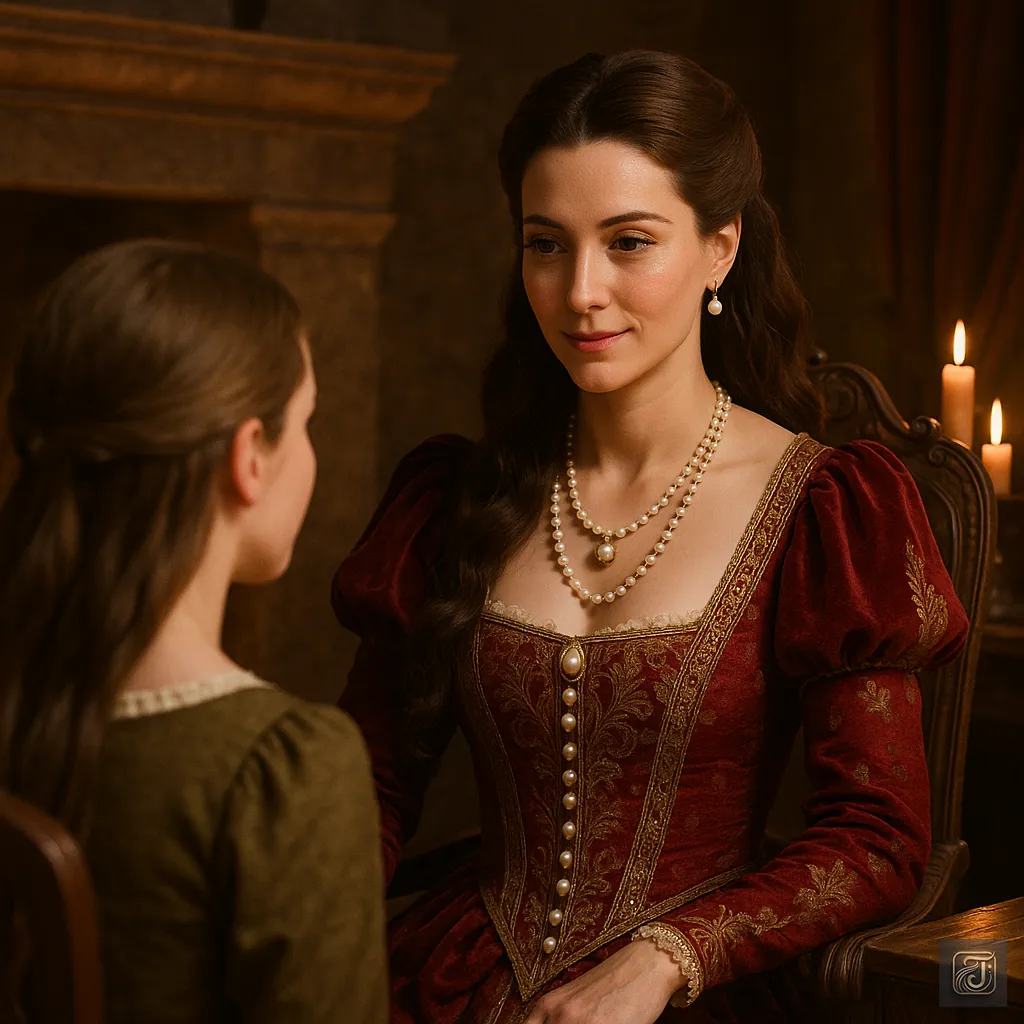
A girl is invited—greeted with kindness and lavish hospitality.
Elizabeth smiles gently, her fingers brushing the girl’s skin, combing through her hair.
Erzsébet Báthory:
“Your skin… it’s like fine porcelain.
Would you be so kind as to share it with me?”
And then—
The moment the door to the dungeon closes,
Her screams echo through the stone halls.

Whips.Branding irons. Nail removal.
Submersion in freezing water.
And when it was done, Elizabeth collected the still-warm blood in a tub—
and bathed in it.
Then, pouring it into a vessel,
she brought it to her lips and drank deeply.
But still—no matter how much she consumed,
aging did not stop.
Her heart was never satisfied.
She would bathe in blood, look into the mirror…
and avert her gaze in quiet, gnawing dread.
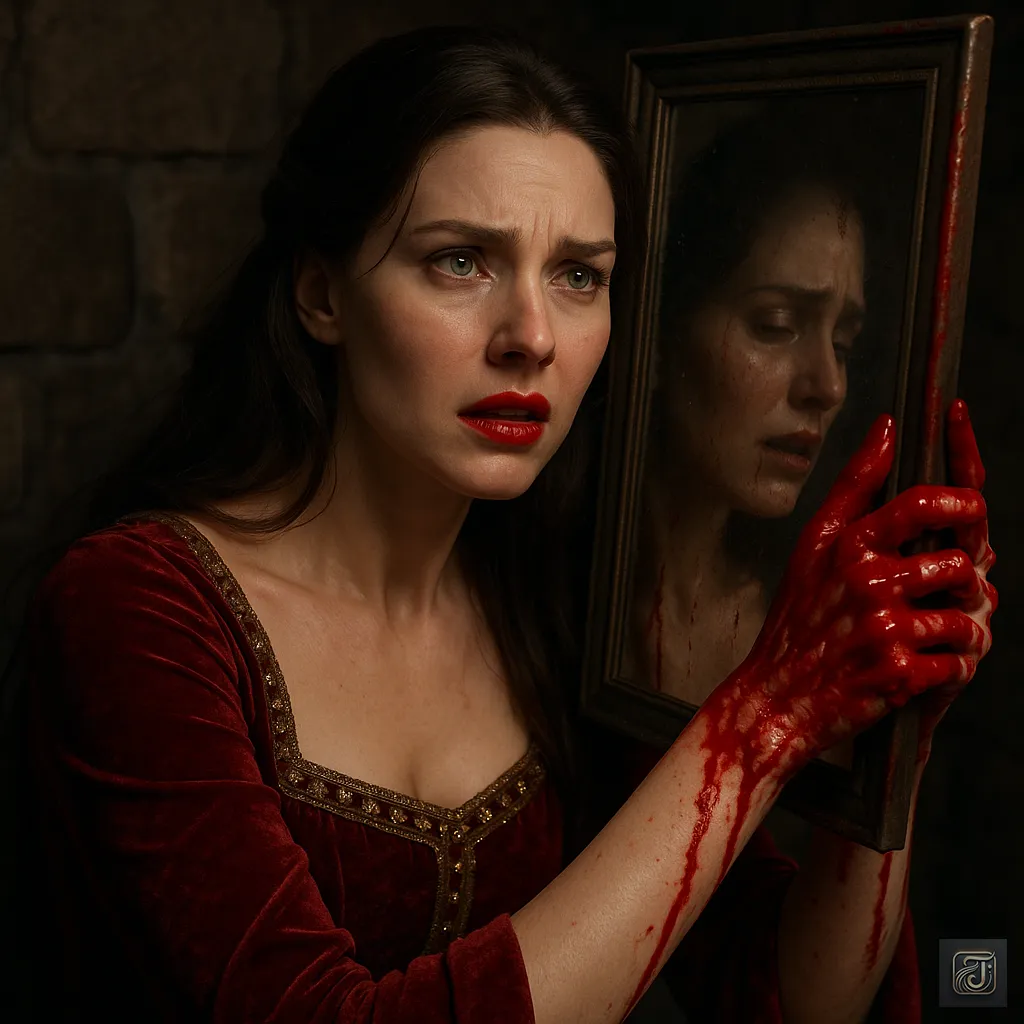
Erzsébet Báthory:
“The demoness of Čachtice Castle.”
“A woman who traded her soul to the devil for flawless skin.”
And at last, when too many daughters vanished from too many villages,
the whispers grew louder—
And the truth began to surface.
But that…
was only the beginning.
Elizabeth’s blood-soaked feast
was far from over.
Chapter 5: Screams Through the Castle Walls
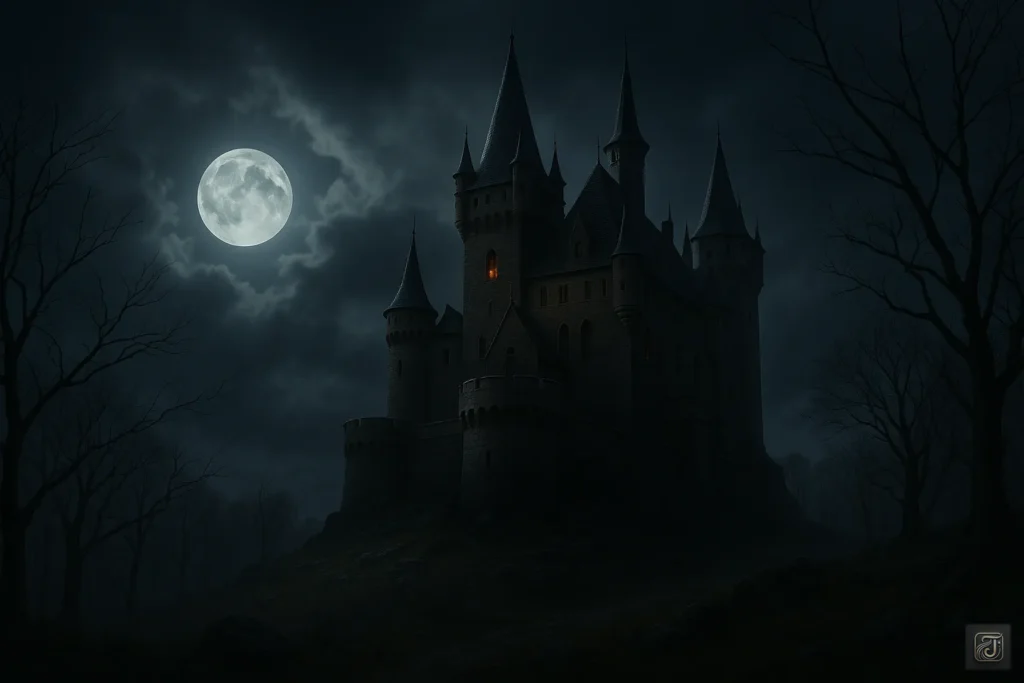
At first, they thought it was just the wind.
But soon, the villagers began to notice a strange sound,
echoing at regular intervals, night after night.
It came from beyond the windows of Čachtice Castle—
a woman’s cry.
Not a scream of pain…
But a voice as if a soul were being torn apart.

Farmer:
“Again…?”
“That’s the third night in a row.”
“And that’s no animal.”
muttered a weary farmer, his eyes fixed on the castle shrouded in darkness.

In the village, many young girls dreamed of serving Lady Elizabeth.
To become a maid at the castle meant good pay, food, shelter—
and the chance to interact with nobility.
Or so they believed.
Indeed, the girls who were summoned to the castle
always departed with bright smiles.
But once they crossed that threshold,
They never came back.
Then one day, in the middle of the village square,
A farmer’s wife named Marka cried out:
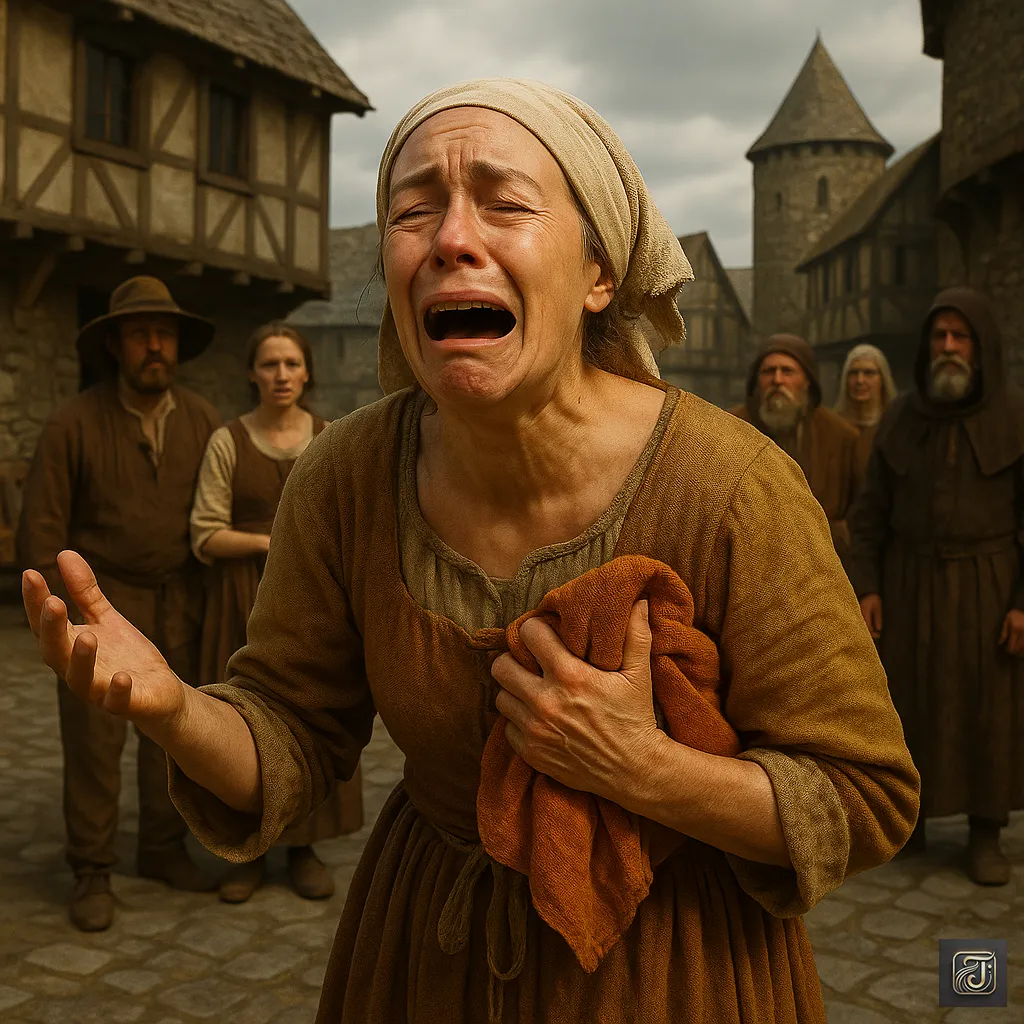
Marka:
“My daughter… she went to the castle three weeks ago, and never came back!”
“She said she’d earn enough money for us all—she promised!”
It was the moment that the unspoken dread,
buried in everyone’s heart,
was finally given voice.
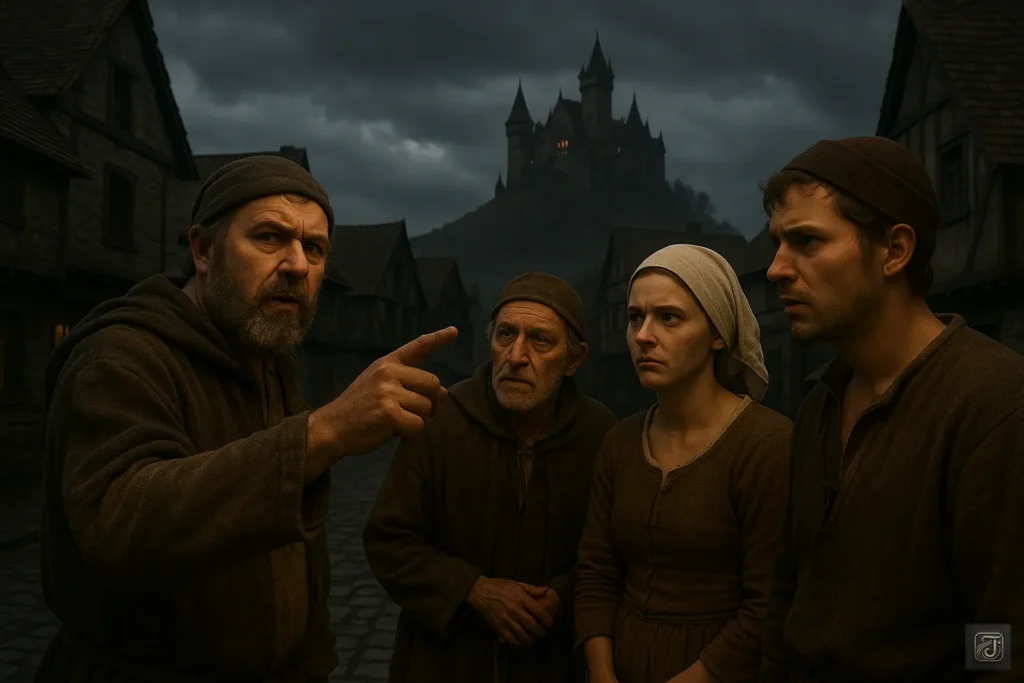
People:
“Come to think of it… my niece too—”
“My cousin went and never came back…”
“Wait… all of them… they all went to Lady Elizabeth’s castle, didn’t they…?”
The air shifted.
Whispers turned to rumors, and rumors reached the royal court.
But the Báthory family’s power was vast.
Local officials, priests—they all stayed silent.

Local officials and priests:
“Without evidence, we can’t lay a finger on that castle.”
“You’d dare oppose a countess?”
But one man broke the silence.
His name was István Magyari—
a minor nobleman… and a grieving father who had lost his daughter.

István Magyari:
“If it’s evidence they want—then I’ll gather it myself.”
With those words, he sent spies into the castle.
What they reported back… was horrifying:
・Torture racks soaked in blood
・Flayed corpses
・Signs that multiple bodies were buried within the castle grounds
・And countless corpses with their faces mutilated beyond recognition

Magyari:
“W-What… what is this!?”
Magyari couldn’t believe his eyes.
“Could she really have… done all this…?”
With trembling hands, he compiled the reports
and delivered them to the royal court.
At last—
The king moved.

On December 29, 1610, King Matthias II of Hungary issued the order:
Elizabeth Báthory was to be arrested.
That very night, soldiers stormed Čachtice Castle—
And what they found was a scene from a nightmare:
a pool of blood, and a mountain of corpses.

A girl lay collapsed in the corner of the hallway.
Another, shackled in the dungeon, was barely clinging to life.
At the center of one chamber were the remnants of what could only be described as a blood ritual—
a scene frozen mid-atrocity.
And standing at the heart of it all—
was Lady Báthory herself,
draped in a crimson dress,
her face still streaked with fresh blood.

Erzsébet Báthory:
“Welcome to my castle,”
She whispered, with a smile.
It was the smile of a woman—
radiant in her beauty, and utterly, irredeemably mad.
Chapter 6: The Fall of Fate

January 1611 — the courtroom within Čachtice Castle was shrouded in a heavy, unnatural silence.
The one to be judged was none other than Elizabeth Báthory, matriarch of one of Hungary’s most powerful noble houses.
And yet—
She did not appear.

The royal envoy:
“The Countess is said to be ill and unable to attend the trial.”
declared the royal envoy.
A murmur rippled through the courtroom.
But everyone knew the truth:
The king feared what might happen if that woman were shown to the public.
And so—
It was her accomplices who were put on trial.

Old Ildikó: sentenced to death—burned at the stake as a witch.
Dorota, the steward: her hands were burned before execution.
Philip, the servant: tortured, then beheaded.
Their testimonies told the whole story—
In brutal, undeniable detail.

“The Countess would smear virgin blood across her face,
then scream that she had ‘grown younger’—and dance with joy.”
“She would extract fat from the bodies of girls
and preserve it as medicine.”
“If a girl displeased her,
She would burn her breasts with heated iron rods.”

And most damning of all—
A servant’s journal was discovered,
recording that the number of victims exceeded 650.
Yet even with all this,
Elizabeth Báthory was never formally tried.
The reason was simple.

She was both “the pride of the Báthory name”
and “a major creditor of the royal family.”
King Matthias II sought a quiet resolution above all.
And so—

Elizabeth Báthory was sentenced to live imprisonment within the tower of her own castle.
The chamber had no windows, no door.
Only a small opening carved into the stone wall,
through which bread and water were passed.
The floor was cold, and even candlelight would not last long.
No voices could reach her.
It was a space entirely cut off from the world.

And that space—
was identical in structure to the dungeon
where Elizabeth herself had once imprisoned her girls.
At first, she still asked for a mirror.

In place of blood, she tried rubbing wine across her face.
But the mirror never came.
And in time, even the wine ran dry.

Months passed, and Elizabeth stopped speaking to anyone.
She began whispering to the walls,
“I am still beautiful.”
Again and again.
But in time—
her nails cracked,
Her hair fell out,
Her skin grew rough,
And her eyes… turned hollow.

August 21, 1614.
When the guard approached the small opening to deliver her food,
There was no reply.
They opened the sealed chamber—
and found her lying silently on the bed.
In her hand, she clutched a portrait of herself
from her youth.

She died at the age of 54.
She was no hero.
No martyr.
But she was—undeniably—a tragic figure,
born from a desperate struggle to remain human.
At the village church where her grave was once erected,
locals stormed in, crying, “Don’t bury that woman here!”
Her headstone was destroyed.
Today, the location of her grave is unknown.

And yet, her name still lingers—
whispered across the world to this day—
as the infamous:
“Blood Countess.”
Final Chapter: The Queen Within the Stone Walls

Even in death, Elizabeth Báthory is still feared—still spoken of.
Some say the air turns cold at the mere mention of her name.
Others whisper, “Call out to Báthory at midnight, and blood will weep from your mirror.”
But what was the truth behind it all?

After Elizabeth’s death, the royal court and the Báthory family imposed a strict veil of secrecy.
Records from the castle were burned, servants were silenced,
and her very existence was nearly erased from history.
But the memory of Elizabeth could not be destroyed.
In fact—
The silence, the cover-up—only served to transform her
into something more:
A legend.
Over the centuries that followed, her story spread—
twisting, evolving, taking on new forms with every telling.

“A vampiress who bathed in virgin blood to preserve her youth.”
“A witch who made a pact with the devil in pursuit of eternal beauty.”
“The most prolific female mass murderer in European history.”
All of them are true.
And none of them are.

Modern historians have suggested that Elizabeth Báthory’s crimes may have been exaggerated—perhaps even orchestrated—as part of a political conspiracy.
– The vast land and wealth held by the Báthory family
– Her arrest as a convenient way to erase the king’s debts
– The questionable nature of testimonies, many extracted under torture
Even the infamous claim that she “killed 650” comes from a maid’s so-called doodle notebook—hardly reliable evidence.
So then—was she innocent?
That… no one can say for certain anymore.
But there is one fact no one can deny:
She was a woman feared.
The smile that lingered in her blood-soaked castle—
Was it that of a monster?
A saint?
Or… merely a lonely woman?
In her final years, it is said she whispered to a guard just once:

Erzsébet Báthory:
“I only wanted to be beautiful.
To live on, without ever being forgotten.”
And in a cruel twist of fate—
That wish was granted.
Her name is etched into history.
The woman who died within stone walls
still lives on,
as the eternal Blood Countess,
whispered through stories across the world.
“I only wanted to be beautiful.
To live on, without ever being forgotten.”
And in a cruel twist of fate—
That wish was granted.
Her name is etched into history.
The woman who died within stone walls
still lives on,
as the eternal Blood Countess,
whispered through stories across the world.
Epilogue

Elizabeth Báthory.
Her life was a tragedy—woven from desire, power, madness, and crushing loneliness.
Yet at the same time, she stands as a mirror—reflecting the darkness that slumbers within us all.
And now that you’ve read her story—
Whose face do you see in that mirror?
(The End)
If you found this article helpful or enjoyable, please consider supporting me with a cup of coffee!👈Click☕🙏
I’m a passionate blogger who loves diving deep into human history and sharing captivating stories about remarkable figures and events from the past.
My blog combines engaging storytelling with beautiful illustrations, making history accessible and enjoyable for everyone.
Currently, I write my blog while managing a full-time job.
Balancing both limits the time I can dedicate to research, writing, and illustrations.
With your support on Ko-fi, I can reduce the time spent on my main job and focus more on blogging, allowing me to increase the frequency of updates and bring you even more captivating stories.
Whether it’s a one-time coffee or a regular contribution, every bit goes directly into making history engaging and fun for my readers.
Thank you for joining me on this journey through time. Let’s uncover the past together!
If you found this article insightful, please consider supporting me ona cup of coffee!👈Click☕🙏
Author: Fuji

Human history is truly complex, isn’t it?
There are countless websites introducing historical figures and events, but many of them are just plain explanations—not exactly exciting to read.
On the other hand, reading books takes a lot of time and effort.
That’s where I come in.
Through “stories that are more engaging than explanations and shorter than books,” I aim to bring the world’s history and humanity’s records to you in a more accessible and interesting way.
If my stories inspire you to love history a little more, I’d be absolutely thrilled!


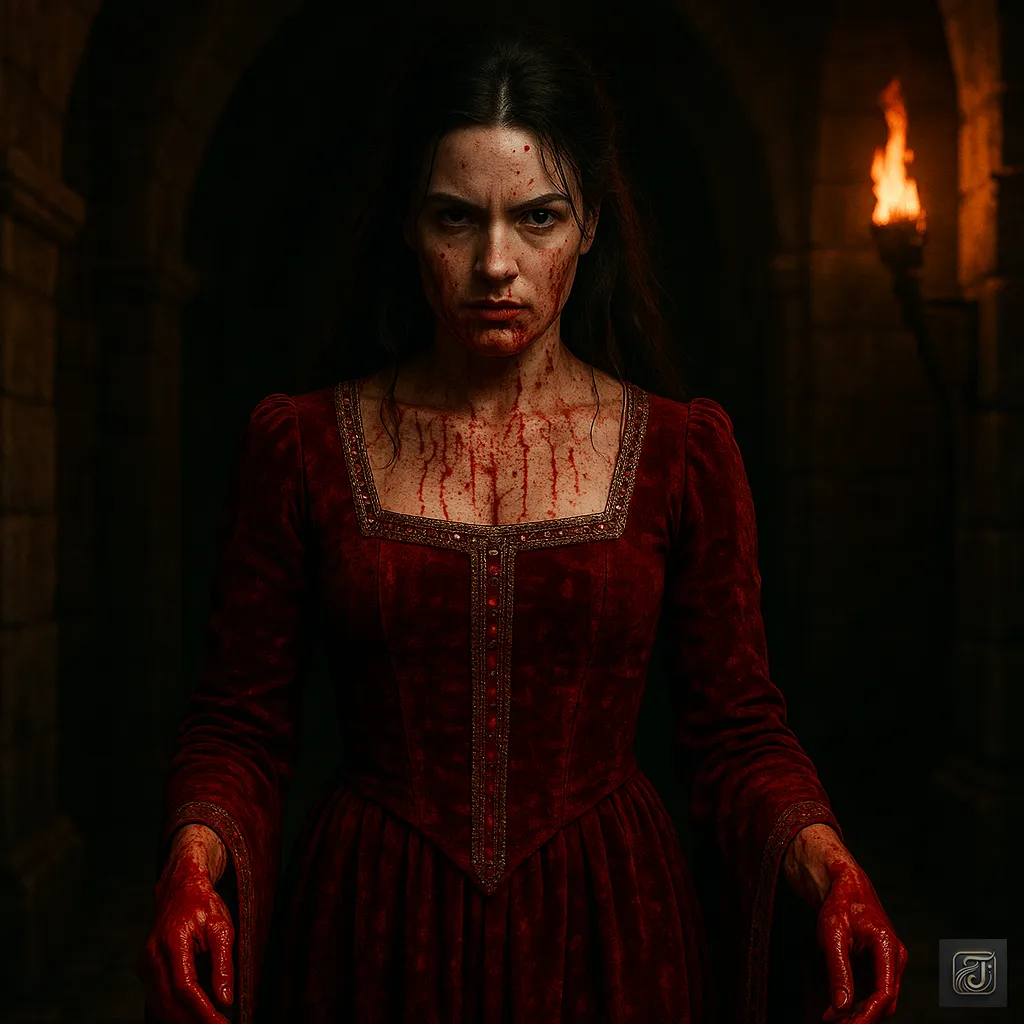


Comment